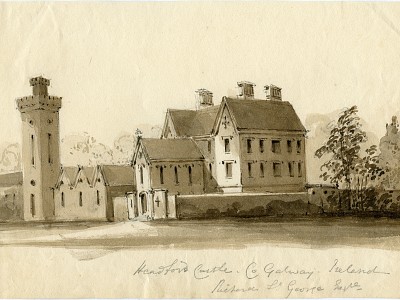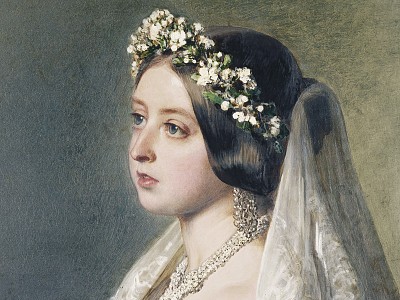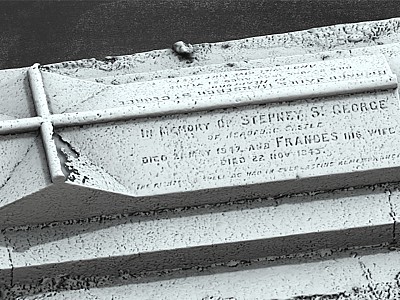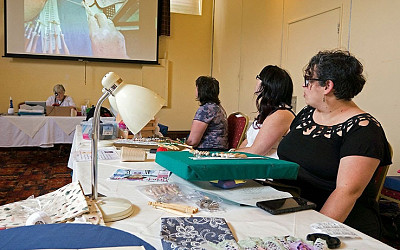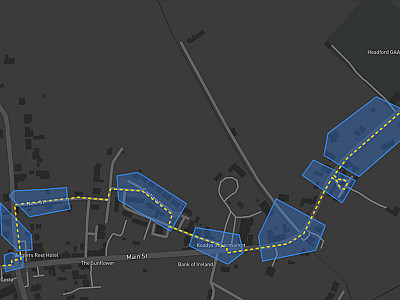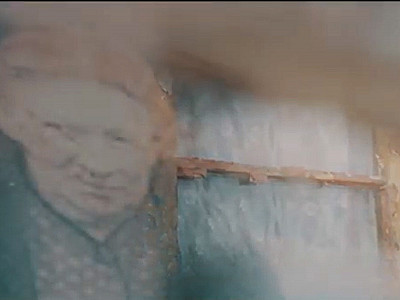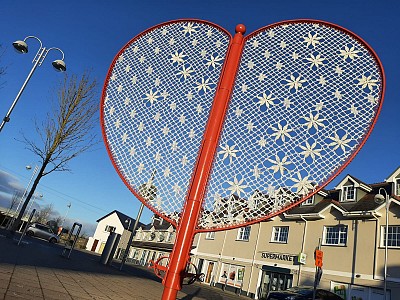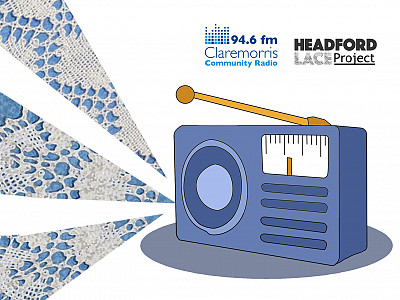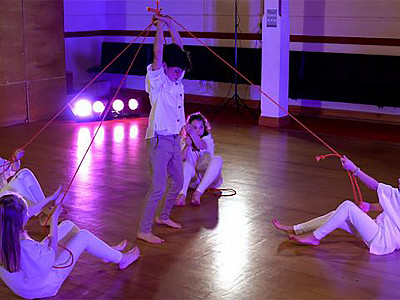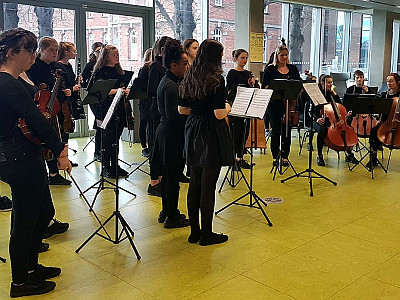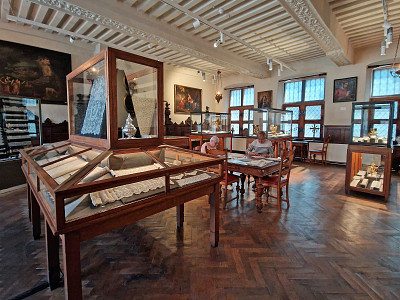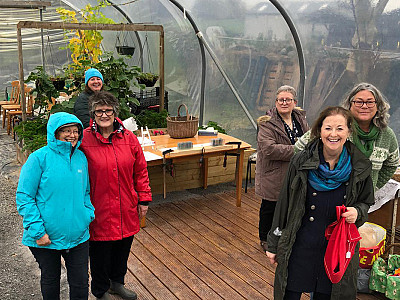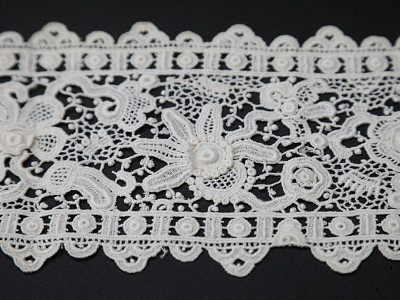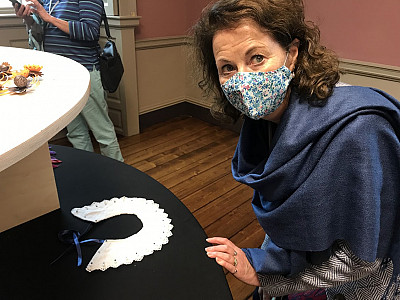If referencing this webpage, please credit Norma Owens, citing the webpage title 'History of Headford Lace' and including the webpage url and the date downloaded.
Introduction
What is presented here is a comprehensive collection of historical references pertaining to Headford Lace, as well as the social, economic, and political context for the lace industry in Headford. Research is ongoing, and so this is a working document that will be updated as new information comes to light. The task of rediscovering the forgotten history of Headford Lace is too large for any one person, and so I wish to acknowledge the contributions of the following people:
Committtee of Headford Lace Project
Ella Hassett
Ger Henry Hassett
Selma Makela
Ester Kiely
Anne O'Hara Quinn
Margie McNamara
Mary O'Connor
Sandra Joyce
Teresa Eagleton
Nora Gildea
Rita Gildea
Brega Webb
Ann Greaney
Marie Boran (Special Collections Librarian, NUI Galway)
Geraldine Curtin (NUI Galway Library)
Patria McWalter (Archivist, Galway County Council)
Roísín de Buitléar
Alex Ward (Curator of Dress and Textiles, National Museum of Ireland)
James Harte (National Library of Ireland)
Brigid Clesham
Ray Hughes
Eugene & Bríd Kearney
Matthew Skic (Museum of the American Revolution)
Thomas McGuire
Maureen Costello (Mayo County Library)
Kay O'Dwyer
The lacemaking industry in Headford is one of the oldest in Ireland. Historical references from the middle of the nineteenth century tell us that it was established one hundred years prior. The earliest contemporary record of lacemaking in Headford was written by Colonel Richard St. George Mansergh St. George and dates to 1790.
To date, we have only one confirmed sample of Headford Lace, which dates to c.1904. Headford Lace is a bobbin lace (also referred to as pillow lace, or bone lace) and that it is specifically of a type known as Torchon.
Lacemaking at Headford dwindled after World War I, and was almost forgotten by the late twentieth century. The Headford Lace Project was established in 2016 as a voluntary community initiative to research, revive, and reimagine Headford’s lacemaking heritage.
Headford Lace Project would be delighted to hear from you if you can share any information about lace, lacemaking, or the lacemakers in Headford. Every little piece contributes to the overall picture, so please do not hesitate to contact us.
Norma Owens (Research & Communications Officer, Headford Lace Project)
1349
The linen thread, from which the lace was originally made, is a fibre extracted from the flax plant; and Headford's association with flax is quite literally legendary. The nearby Franciscan Friary of Ross Errilly was founded in 1349 by Dr. Malachy McHugh, who was then Archbishop of Tuam. At the time, the area was in the grip of The Black Death. Legend says that the archbishop was praying in the church for an end to the plague when he fell into a deep sleep. He dreamed that he was visited by an angel who told him that his prayers would be answered if he built a friary. He was instructed to go west from Tuam to Headford, to the townland of Cordarra, and there he would be given a sign. The following morning, the archbishop set off and, after a short time, he saw three swans, each with a bunch of flax seed in its bill. The swans circled McHugh three times and then flew westward toward the Black River, where they landed on some marshy ground near the riverbank. By the time the archbishop arrived, the swans were gone, and in their place were three bunches of flax that were in full bloom even though it was still only the month of February. The archbishop understood this to be the heavenly sign he had awaited. He retreated to the nearby church of Killursa, where he prayed and fasted before commencing the building works. It is said that as soon as the foundations were completed, the plague ended. The first stage of construction took three years, but the archbishop himself never got to see it as he died from the plague in 1349.Galway County Heritage Office (2017) 'Ross Errilly Friary'The foundation of the friary is mentioned in the Annals of the Four MastersO'Donavan, John (1854) Annals of the Kingdom of Ireland by the Four Masters, from the earliest period to the year 1616. Volume III. Dublin: Hodges and Smith, p. 598. and its placename is commonly believed to take its name from this legend, as a derivation of the Irish Ros na dtrí Eala, which translates as "flaxseed of the three swans."Wilde, William Robert (1872) Lough Corrib: Its Shores And Islands: with notices of Lough Mask. Dublin: McGlashan & Gill, pp. 112-113. However, early sources record the name as Mainistir Ros Oirialaigh or Ross-ne-threallagh.
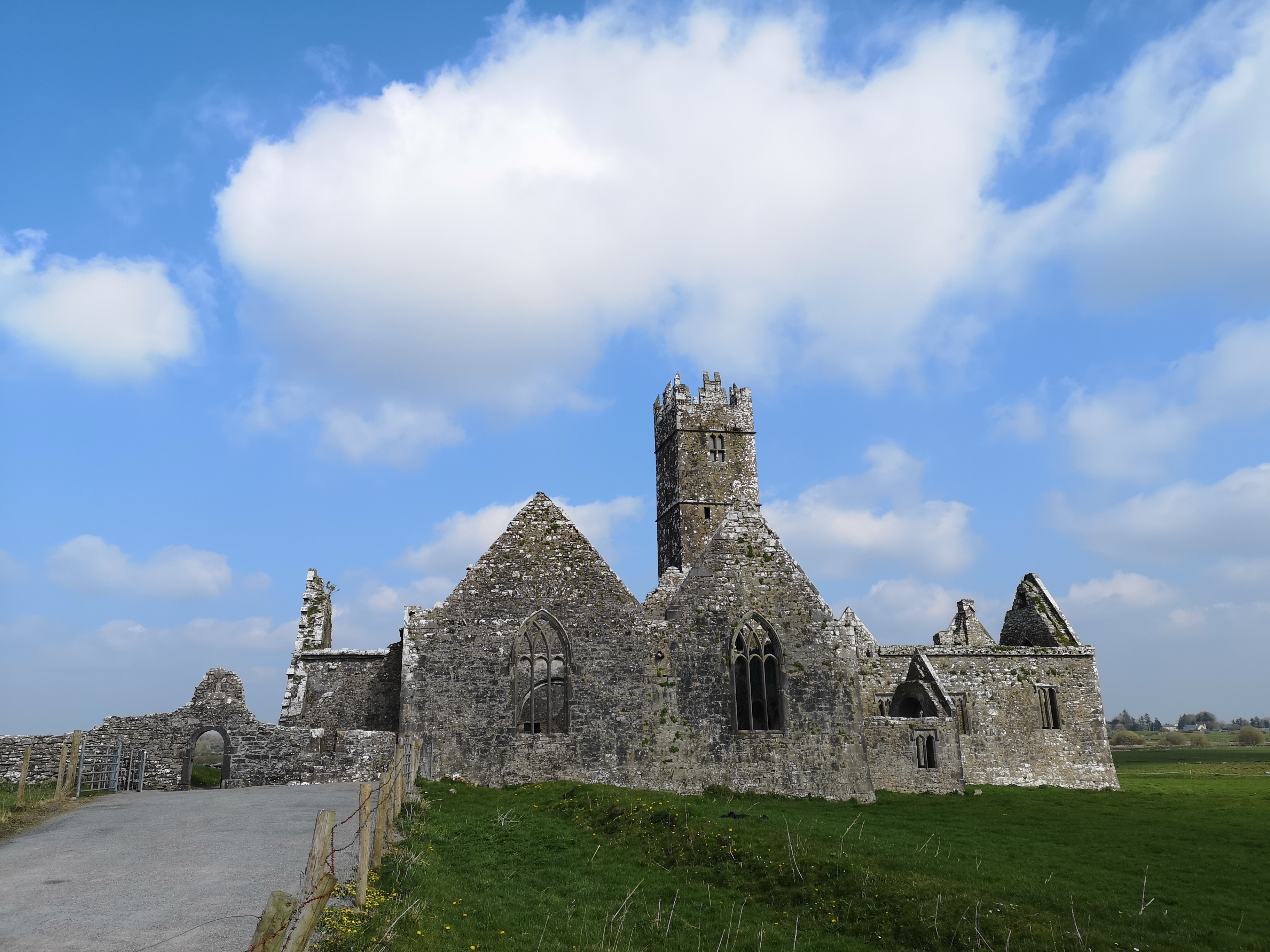
Ross Errilly. Photograph by Norma Owens
1652
Edmund Skerrett is expelled from Headford Caslte by the Cromwellian commissioners of Ireland and the castle and estate is granted to Sir George St. George (1583-1660). St. George ownership of this land was confirmed by royal patent in October 1666.O'Byrne, Robert (2017)Tyrone House and the St. George Family: The Story of an Anglo-Irish Family. Bloomington, Indiana: Xlibris, p. 38. We know that Sir George's grandson, Lord George St. George (1658-1735) inherited Headford Castle and became renowned as an uilleann piper.O'Byrne, Robert (2017)Tyrone House and the St. George Family: The Story of an Anglo-Irish Family. Bloomington, Indiana: Xlibris, p. 38.
1749
In the 1740s, Headford Castle is occupied by Olivia Ussher St. George (d. 1765)Foot, Jesse (1811) The Life of Arthur Murphy, Esq. London: J. Faulder, pp. 10, 47-49. See also: National University of Ireland, Galway (2011) 'Estate: St. George (Headford)'., the granddaughter and heiress of Lord George St. George. Olivia married Arthur French of Tyrone House on 23 January 1736Lundy, Darryl (2019) 'Olivia Ussher' F, #334828 in 'The Peerage'.. In 1749, Arthur French's nephew, Arthur Murphy (1727-1805), writes from Headford that Mrs. French “has erected a spinning school near her, manufactures a great deal of linen”.Foot, Jesse (1811) The Life of Arthur Murphy, Esq. London: J. Faulder, pp. 10, 47-49. Arthur Murphy was a nephew of Arthur French through the latter's sister, Jane, who married a London merchant named Richard Murphy. Richard was drowned en route to America in 1727 and his son was subsequently raised at the French's estate in Cloonyquin, near Tulsk, Co. Roscommon.O'Byrne, Robert (2017)Tyrone House and the St. George Family: The Story of an Anglo-Irish Family. Bloomington, Indiana: Xlibris, pp. 12; 52-54.
The work of Olivia Ussher St. George ensured a local supply of linen thread, a raw material of the lacemaking industry.
1753
A story about Ross Errilly describes:
In 1753 is recorded the last flight of the religious from the walls of Ross-Errily. The property had passed from the Clanricardes to Lord St. George, who continued to protect the inmates of the monastery, although the statutes of the land enacted imprisonment for life as the penalty for contributing to the support of a Catholic priest. In the year we have mentioned, Lord St. George successfully terminated a suit in which he was involved with a family of Iar Connaught. The defeated parties vowed vengeance against their antagonist, and swore informations to the effect that Lord St. George had under his protection some members of a religious community, the tower of whose monastery could be seen from the windows of his lordship's castle at Headford. The government of the day resolved at once to inquire into the accuracy of these informations, though prima facie it seemed absurd that a Protestant nobleman would show such courtesy to the proscribed friars of the Catholic Church. Fortunately Lord St. George received some friendly hint of the approaching storm. He and the religious were now alike imperilled. These however quitted the monastery without delay, and so arranged the place that no traces remained of its former inmates. Looms were got in; weavers were set to work; and the whole place assumed the appearance of some large factory; the walls, moreover, and the ceiling, hitherto adorned with frescoes, were now whitewashed; and when the government commissioners arrived, they were able to report that there was not a solitary friar on the premises, and that Ross-Errily was not a monastery, but a manufactory. The Franciscans, at their departure, took with them the church plate, ornaments, and vestments, and retired to a small island formed by the Black river, where they built a small convent, the foundations of which still remain, and whence they could see the lofty tower of the old monastery, which had once been their home. That island to this day is called Hyauwn-na-braugher, i.e. "the Friar's Island". Thenceforth Ross-Errily was nothing more than a crumbling ruin; but its tower, its ivied gables, its columned aisles, its ornamental windows; still proclaim the former grandeur of this home of piety and science.Library Ireland (2015-2018) 'The Abbey of Ross-Errily'
This account gives an idea of the scale of the textile industry in Headford at this time, given that the existence of a factory in the friary seemed plausible to government officials.It is not clear who the 'Lord St. George' in this report refers to, as Lord George St. George had died in 1735. While Olivia French's brother, St. George Ussher St. George, was created 1st Baron Saint George of Hatley St. George (Co. Roscommon), he was not raised to the peerage until 24 May 1763 and he resided at Hatley St. George in Co. Roscommon.
ca. 1766
Writing about pillow lace (another name by which bobbin lace is known) in 1866, WadgeWadge, E. Harvey [Ed.] (1866) ‘The Irish Industrial Magazine’. Dublin: McGlashan & Gill, p. 203. and Parkinson & SimmondsParkinson, Henry & Lund Simmonds, Peter [Eds.] (1866) ‘The Illustrated Record & Descriptive Catalogue of the Dublin International Exhibition of 1865’. London: E. and F. N. Spon, p. 273. state that:
About 100 years ago, the manufacture of this beautiful fabric was introduced to Headford, a little town in the West of Ireland, by one of the ladies of the St. George family”. The writer goes on to paint a less-than-flattering picture ... "It was then a poor, filthy hamlet, because all the labour of providing household comfort devolved on the men [...] And no doubt, as the women afforded no help in keeping the many, there was weeping enough when rent days came round, or death visited the inhabitants of Headford. Mrs. St. George was not an imaginative woman; her ambition was to make her tenants industrious, to teach them to know and feel the profitableness of industy; being confident that, if this was once accomplished, comfort, and cleanliness, and thrift would follow. The result justified her wisdom. A marking epoch arrived in the annals of the hamlet, when Mrs. St. George established a school for the instruction of girls in pillow lace making; and this wise and noble act had the effect of so entirely changing the social condition of the inhabitants of Headford, that in a few years they became as remarkable for their industry, forethought, and neatness, as they had before been for the opposite qualities. As years went on, the prosperity of the place increased; merchants' travellers visited it to buy the lace, and leave extensive orders; huts gave place to comfortable cottages; and large well-stored shops were opened to supply the increasing wants of the people.Parkinson, Henry & Lund Simmonds, Peter [Eds.] (1866) ‘The Illustrated Record & Descriptive Catalogue of the Dublin International Exhibition of 1865’. London: E. and F. N. Spon, p. 273.
Historical records usually omitted the first names of women. However, property records show that the chatelaine of Headford Castle at this time was Mary St. George.
In 1753, Lieut. Gen. Richard St. George (1670-1755), a second cousin of Lord George St. George, is recorded as the owner of Headford castle and its estate. He was the second cousin of the uilleann piper, Lord George St. George of Headford Castle, and grandson of Capt. Richard St. George (1590-1667), governor of the town and castle of Athlone.O'Byrne, Robert (2017) Tyrone House and the St. George Family: The Story of an Anglo-Irish Family. Bloomington, Indiana: Xlibris, pp. 22-23. It is not clear how the castle transferred ownership from one branch of the family to the other.

Inheritance of Headford Castle
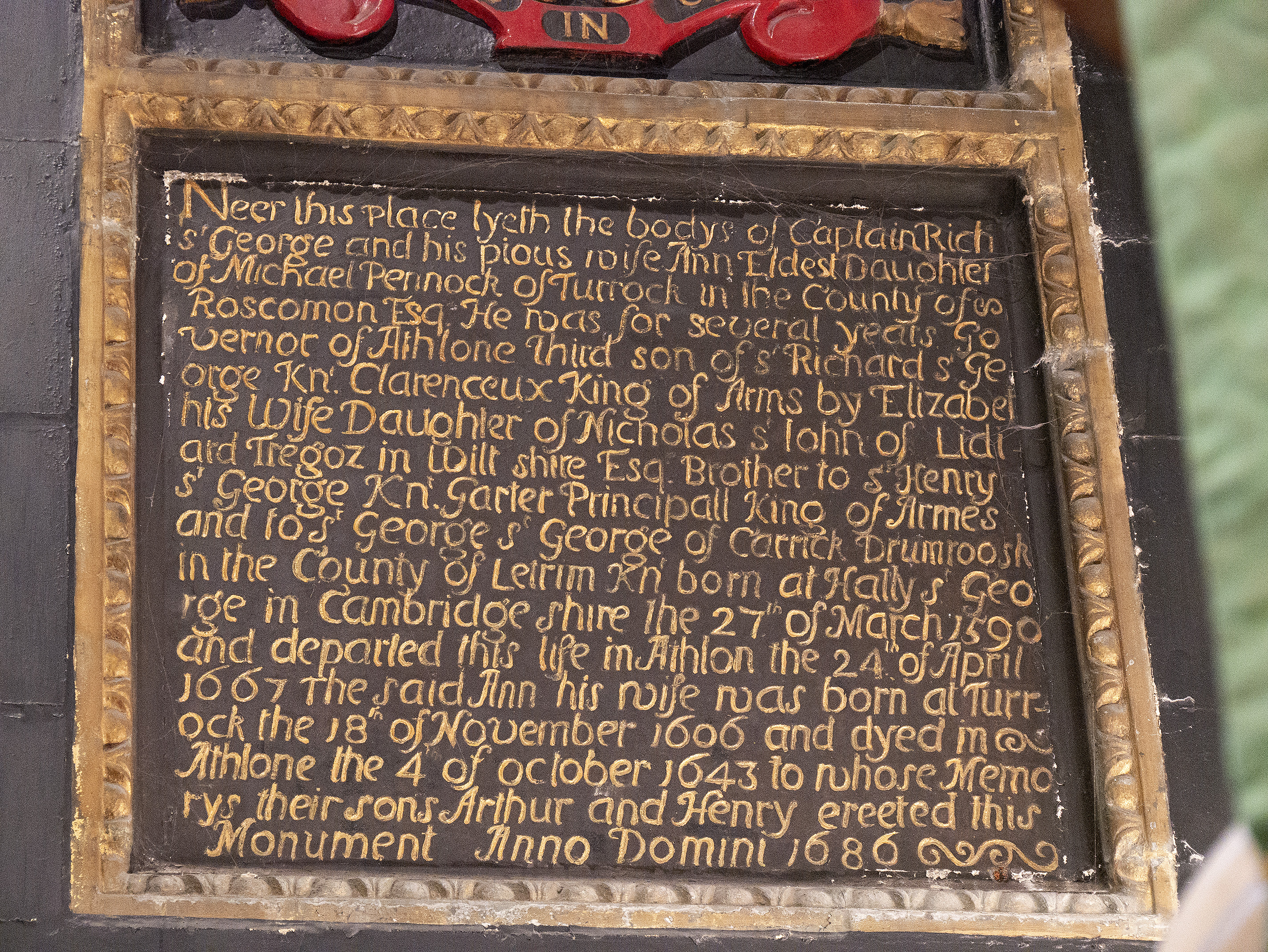
St. George grave in St. Mary’s Church of Ireland, Athlone
On 15 July 1749, Mary St. George became the second wife of Captain James Mansergh (c.1725-1772), the son of Mary Southcote and Daniel Mansergh (d. c.1724) of Macrony Castle, Kilworth, Co. Cork. (His first wife had been Elizabeth Gifford, daughter of John Gifford of Ahern, Co. Cork.)Burke, Sir Bernard (1912) A Genealogical and Heraldic History of the Landed Gentry of Ireland. London: Harrison & Sons, p. 455. Mailí San Seoirse, or 'Molly St. George', written by Thomas Connellan from Co. Sligo, is one of the oldest known Irish harp tunes with extant lyrics and is said to have been inspired by this lady (Molly being a common petname for Mary).O'Byrne, Robert (2017)Tyrone House and the St. George Family: The Story of an Anglo-Irish Family. Bloomington, Indiana: Xlibris, p. 38.
1771
Colonel Richard St. George Mansergh (1752-1798)Barker, G. F. Russell (1920) The Record of Old Westminsters: A Biographical List of all those who are known to have been educated at Westminster School from the earliest times to 1927, Vol. II. London: Chiswick Press, p. 818., son of Capt. James Mansergh and Molly St. George, inherits Headford Castle. As the terms of the inheritance prescribe, he adopts the surname St. George, thereby becoming Richard St. George Mansergh St. George.'The Hampshire Chronicle: Or, Winchester, Southampton, and Portsmouth Mercury' Vol. III. Monday, 19 September, 1774, p. 1. See also: 'Saunders's News-Letter No. 5352'. Friday 16 - Monday 19 September 1774, p, 1.
1775
Col. Richard St. George Mansergh St. George employs Charles Frizell Jr. to survey his estate. Among Frizell's recommendations is that 'there are several Looms in the Town if Encouragements is given to Linen Manufacturers to settle may in some time hence flourish.'Frizell, Charles Junior) (1775) 'Maps of the Estate of Richard St. George Mansergh St. George Esqr in the County of Galway in 1775'Maps of the Estate of Richard St. George Mansergh St. George Esqr in the County of Galway in 1775', p. 6. Available at Galway County Library. Reference: GSO1/5.
Late 1700s
Parkinson & Simmonds note that 'the prosperity of the place increased; merchants’ travellers visited it to buy the lace, and leave extensive orders'.Parkinson, Henry & Lund Simmonds, Peter [Eds.] (1866) ‘The Illustrated Record & Descriptive Catalogue of the Dublin International Exhibition of 1865’. London: E. and F. N. Spon, p. 273.
1777
Col. Richard St. George Mansergh St. George fights for the British Empire in the American War of Independence. Fellow officer, Lieutenant Martin Hunter, considered St. George 'quite military mad'. As Martin recounts: 'I often thought that St. George wished to be wounded, as he frequently said, "Tis very extraordinary that I don't get a clink, for I am certain I go as much in the way of it as anybody".'Hunter, Sir Martin; Hunter, Dickson; Lady, Jean; Hunter, Anne; Bell, Elizabeth; and James; Hunter (Eds.) (1894) 'The journal of Gen. Sir Martin Hunter, G.C.M.G., G.C.H.: and some letters of his wife, Lady Hunter'. Edinburgh: Edinburgh Press, pp. 21-22.
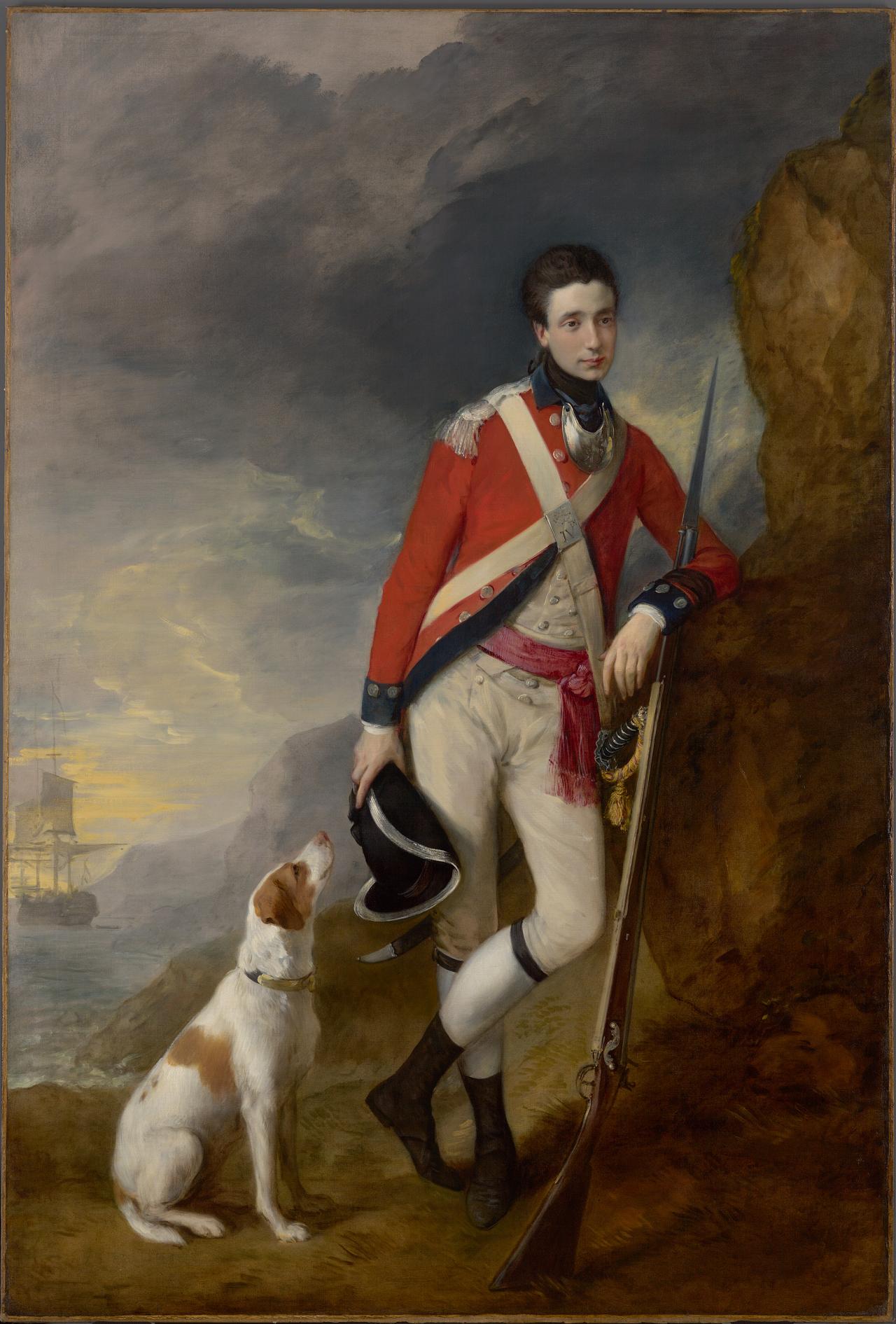
Richard St George Mansergh-St George (c. 1776-1780) by Thomas Gainsborough. Image courtesy of the National Gallery of Victoria, Australia.
In 1777, St. George is shot in the head at the Battle of Germantown, near Philadelphia. In the years that followed, he would travel frequently to France or Italy so that the warmer climate might ease his head pain. In Naples, he meets artist Xavier della Gatta, and he works with him to create a painting of the Battle of Germantown and another painting of the Battle of Paoli.Museum of the American Revolution. 'Richard St. George's Life and Death' St. George had himself included in the Germantown image (bottom left) being carried from the battlefield by Corporal George Peacock. St. George was so grateful to Peacock for his act of mercy that he gave him fifty guineas, 'gold coins that would be the equivalent of about three years' of corporals' pay.'McGuire, Thomas J. (2006) The Philadelphia Campaign: Germantown and the roads to Valley Forge, Vol. II. Delaware: Stackpoole Books, p. 131.
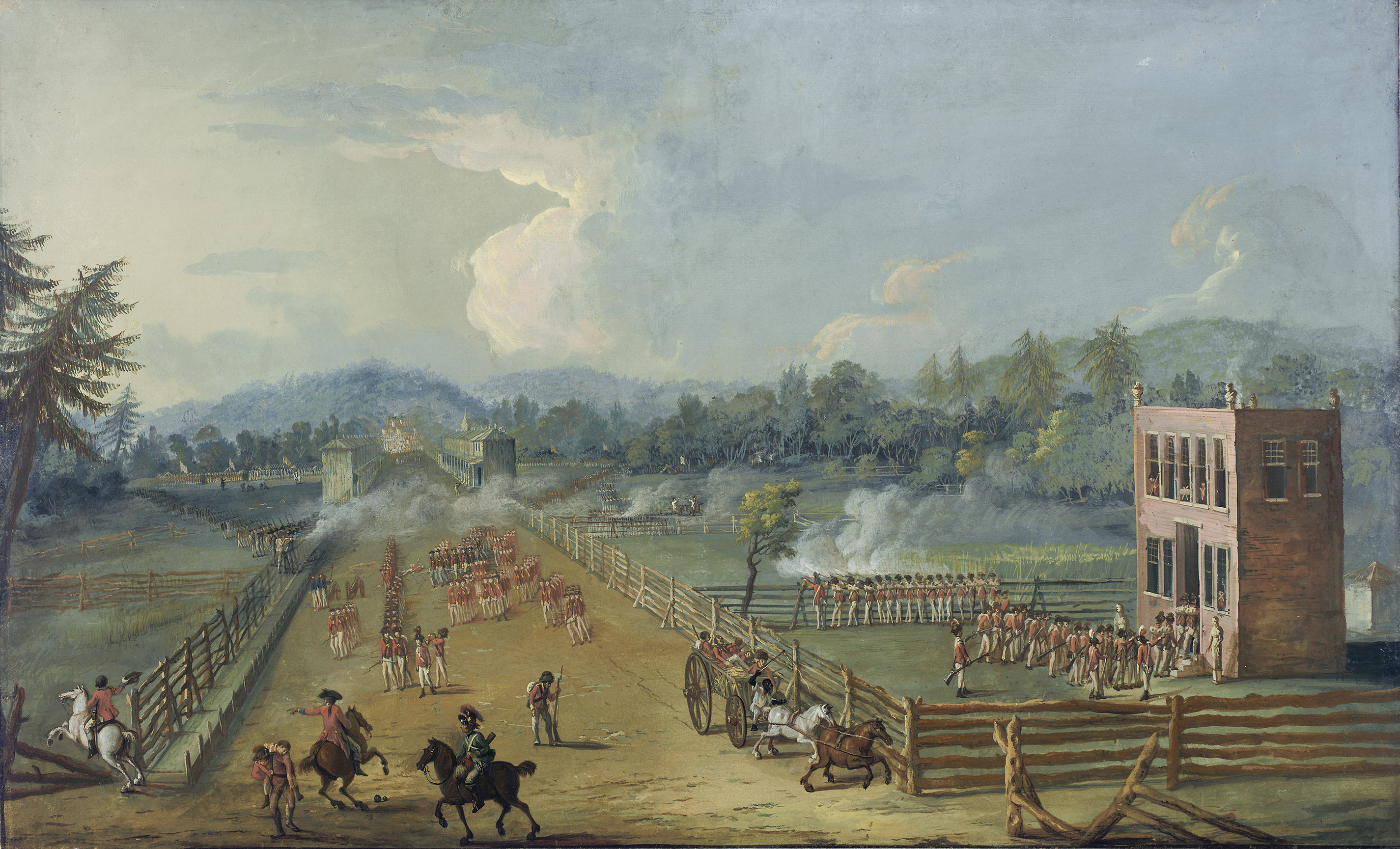
Battle of Germantown (1782) by Xavier della Gatta. Courtesy of the Museum of the American Revolution.
After the battle, St. George is trepanned (a portion of his skull was removed) and he is fitted with a silver plate to cover the hole. During this procedure, the patient is required to remain conscious and sitting upright. St. George’s friend Lieut. Martin Hunter remarked that 'He bore the whole operation without saying one word.'Hunter, Sir Martin; Hunter, Dickson; Lady, Jean; Hunter, Anne; Bell, Elizabeth; and James; Hunter (Eds.) (1894) 'The journal of Gen. Sir Martin Hunter, G.C.M.G., G.C.H.: and some letters of his wife, Lady Hunter'. Edinburgh: Edinburgh Press, p. 22. Thereafter, St. George always wore a black silk cap to hide the wound and was described as having 'phases of insanity'Bowen, Elizabeth (2015) Bowen's Court & Seven Winters. New York: Random House. as a result of the head injury.
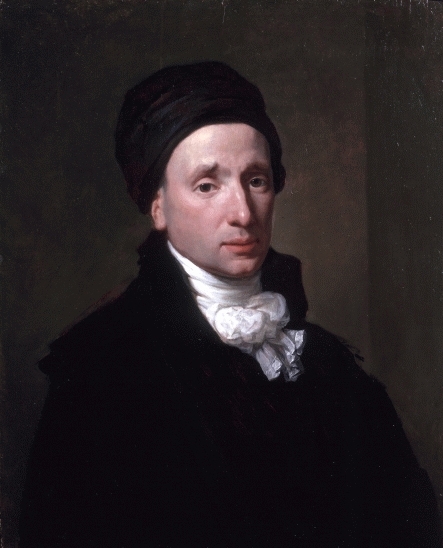
Portrait of Richard Mansergh St George 1791 by Hugh Douglas Hamilton. Image in public domain.
1788
'St. George corresponded all the time he was in America with a Mrs-, whom I believe he afterwards married,' according to his friend and fellow soldier, Lieutenant Martin Hunter.Hunter, Sir Martin; Hunter, Dickson; Lady, Jean; Hunter, Anne; Bell, Elizabeth; and James; Hunter (Eds.) (1894) 'The journal of Gen. Sir Martin Hunter, G.C.M.G., G.C.H.: and some letters of his wife, Lady Hunter'. Edinburgh: Edinburgh Press, p. 22. The identity of Richard's unnamed lady friend, whom he addressed as “O Imperial”,Unknown author [identified by Stephen Gilberts at Lieutenant Richard St. George Mansergh St. George] (1777). ‘From the Camp on the Field of Battle near Delworth on the heights of Grand Wine September 11th at night’. Anthony Wayne Papers, Vol. 4, manuscript 0699, Historical Society of Pennsylvania, Philadelphia. was unconfirmed for centuries but, in 2020, Norma Owens identified her Anne Stepney of Durrow Abbey, Co. Offaly by confirming that she had been married to Benjamin Burton Doyne at the time of the American Revolution. After Benjamin's death in 1787, Anne married Richard.Burke, Sir Bernard (1912) A Genealogical and Heraldic History of the Landed Gentry of Ireland. London: Harrison & Sons, p. 455. The couple would have two sons within three years: Richard James Mansergh St. George (1789-1857) and Stepney St. George (1791-1847).Burke, Sir Bernard (1886) A Genealogical and Heraldic History of the Landed Gentry of Great Britain and Ireland (7th Edition), Vol. II. London: Harrison & Sons, p. 1604.
Read a more detailed account of Richard Mansergh St. George and Anne Stepney (formerly Doyne) here.
1790
In 'An account of Galway' by Richard St. George Mansergh St. George, he remarks: 'The women at Headford make lace'.St George, Richard St. George Mansergh (1790) 'An account of Galway by Richard St. George Mansergh St. George'. IE TCD MS 1749/2, Trinity College Dublin. This is the first contemporary record of lacemaking in Headford, and one of the oldest of a lace industry in Ireland.

Image courtesy of Trinity College Library Dublin
1791
George Romney paints a portrait of Anne (Stepney) St. George in which she is pregnant with her second son, Stepney.Personal communication from Dr. Martin Mansergh. Her first son, Richard James Mansergh St. George, appears in the painting with her, leaning his head in her lap. Mrs. St. George began sitting for Romney on 21 July 1791 and, in total, it took Romney four sittings to complete the portrait of her and ten sittings to complete the portrait of Master St. George.Humphry, Ward and Roberts, W. (1904) Romney: A Biographical and Critical Essay with a Catalogue Raisonné of his Works, Vol. II. London, Thomas Agnew & Sons; New York: Charles Scribner's Sons, p. 138. In the painting, Mrs. St. George is depicted wearing a Turkish costume, which was in fashion at the time. Richard St. George Mansergh St. George commissioned the painting, and paid Romney 200 guineas in advance for the portrait.The Hecksher Museum (1979) Catalogue of the Collection. Huntington, New York: The Hecksher Museum. The painting hung at Headford Castle until 1888, when it came into the possession of Mrs. Winn, granddaughter of Mrs. St. George.The American Art Association (1920) Illustrated Catalogue of Highly Important Old and Modern Paintings of Sterling Artistic Distinction. New York: The American Art Association, No. 153. The painting currently hangs in the Heckscher Museum of Art in Huntington, New York.
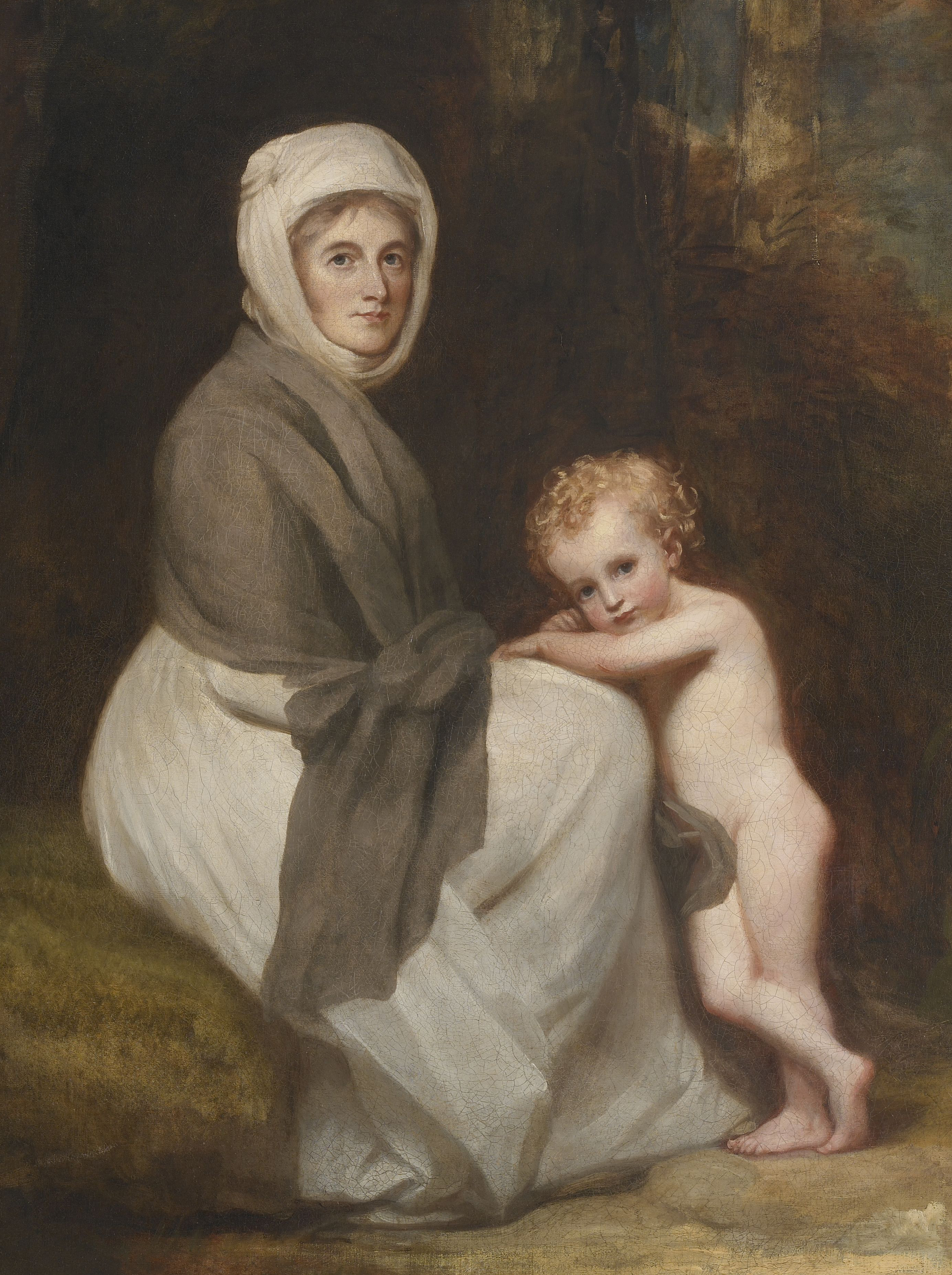 Anne St. George née Stepney (1791) by George Romney. Image courtesy of the Hecksher Museum of Art.
Anne St. George née Stepney (1791) by George Romney. Image courtesy of the Hecksher Museum of Art.
1792
Anne (Stepney) St. George dies in August at a St. George family estate in Clifton, near Bristol. Her husband carries her remains back to Ireland.Bury & Norwich Post,22 August 1792, 'Died', p. 2; Dublin Evening Post, 30 October 1792, p. 3.
1796
Col. Richard St. George Mansergh St. George commissions a portrait of himself mourning his wife. St. George himself intended to never see the painting. Instead, he wished that it be shown, upon their reaching maturity, to his children, who were being sent away to stay with guardians and who St. George feared he may never see again. Tormented with grief by his wife’s death, he writes the following:
In the Mansion house I shall build a room where [the Painting] shall be desposited [...] Instructions shall be left so [...] The Images of their Father and Mother may appear to [my Children] in the terrible circumstances I have conveyed to you. I have a material purpose in this which may be frustrated perhaps, it depends on their nature, but I conceive This dreadful and strange apparition may by a sudden and powerful impulse (inducing them eagerly to read the history contained in the volumes which shall be desposited in a Trunk in the room with the Picture of which they shall have had no previous intimation) produce the effects I wish for and hourly fill my thoughts.Cullen, Fintan (2000) Sources in Irish Art: A Reader. Cork: Cork University Press, p. 46
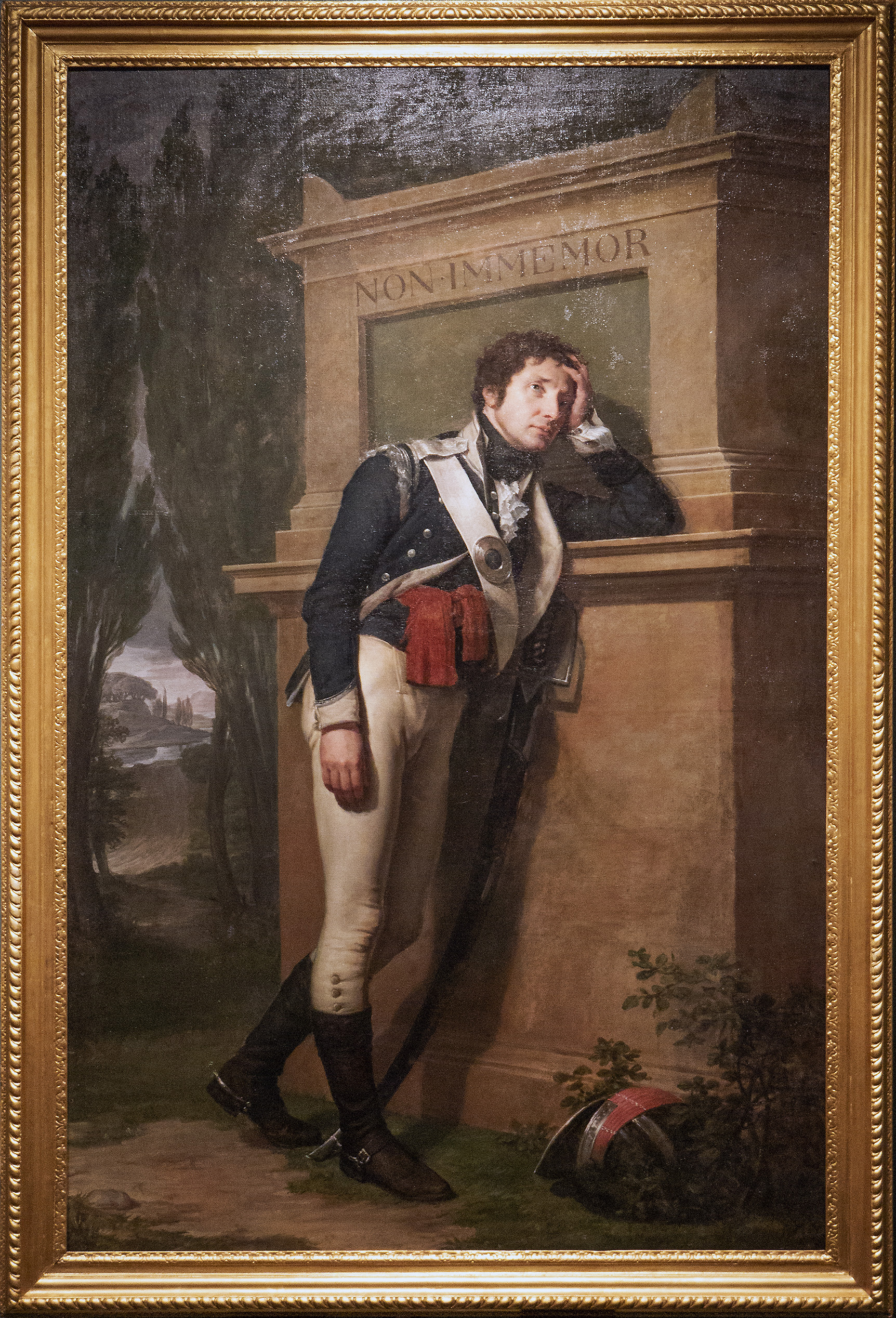
'Lieutenant Richard Mansergh St. George' (c.1796) by Hugh Douglas Hamilton. From the collection of the National Gallery of Ireland and photographed at the 'Cost of Revolution: The Life & Death of an Irish Soldier' exhibition at the Museum of the American Revolution.
1798
On 9th February 1798, Richard St. George Mansergh St. George travelled to his Araglin estate in Cork (that he inherited from his father) to 'upbraid his assembled tenantry for their “insurrectionaly spirit” and for felling his trees. Accompanied only by his agent, [Jasper] Uniacke and an escort of two soldiers, he declares his intention to burn more houses and “transport every United Irishman he could discover amongst them”.'The Irish Times, 14 February 1998. 'Captain Doe's men kill 2 after threats'. On 12th February, 'a group of some thirty rebels from Counties Cork and Tipperary arrived at the house of Jasper Uniacke.' O'Byrne, Robert (2017) <em>Tyrone House and the St. George Family: The Story of an Anglo-Irish Family</em>. Bloomington, Indiana: Xlibris, p. 40. Both Richard and Jasper were killed by the rebels and Mrs. Uniacke [Maria, née Andrews]Burke, i.r Bernard (1912) A Genealogical and Heraldic History of the Landed Gentry of Ireland. London: Harrison & Sons, p. 713. was injured while trying to save her husband. She survived and identified two of the assailants, John Haye and Timothy Hickey, at their trial later in 1798. Both men were found guilty and executed at Araglin and a third man, Patrick Hynes, was later found guilty and hung for the same crime.Skic, Matthew (2019) Cost of Revolution: The Life and Death of an Irish Soldier. Philadelphia: Museum of the American Revolution, p. 112
Headford Castle and its estate are inherited by the St. George's elder son, Richard James Mansergh St. George, a minor.
1812
On 13 February, Richard James Mansergh St. George marries Elizabeth Sophie Shaw, second daughter of William Cunliffe Shawe Esq. of Southgate House, Middlesex. The couple would have no children.Burke, Sir Bernard (1886) A Genealogical and Heraldic History of the Landed Gentry of Great Britain and Ireland (7th Edition), Vol. II. London: Harrison & Sons, p. 1604.
1817
On visiting Headford, John Bernard Trotter commented:
We were very glad to observe, in the cabins skirting Headfort, many of the women employed in making lace. In Ireland the women want employment very much, unless where the linen-manufacture exists. It is true, that they often assist in the labours of the field in small farms; but it is painful to see them exposed to weather and such hardship. The more the smaller domestic manufactories are spread among them - such as knitting, spinning, making lace, &c. &c. the more the condition of the poor will improve.” He goes on to say that “As the following day proved to be the market one, we saw the place to much advantage, enlivened by the rustic crowd, and exhibiting the bustle of internal trade and manufacture, greatly protected and encouraged by the proprietor, Mr. St. George. He has established a mart for the sale of flannels, and gives premiums for the best pieces, and largest quantity sold. We saw a good deal of it, and abundance of the usual country commodities, in the market.Trotter, John Bernard (1775-1818) Walks Through Ireland in the Years 1812,1814, and 1817: Described in a Series of Letters to an English Gentleman. London:Sir R. Phillips and Co, pp. 421; 419.
1824
'Mr. St. George gives premiums for the encouragement of the linen and flannel manufactures.'Dutton, Hely (1824) A Statistical and Agricultural Survey of the County of Galway: with observations on the means of improvement. Dublin: University Press, pp. 330-331.
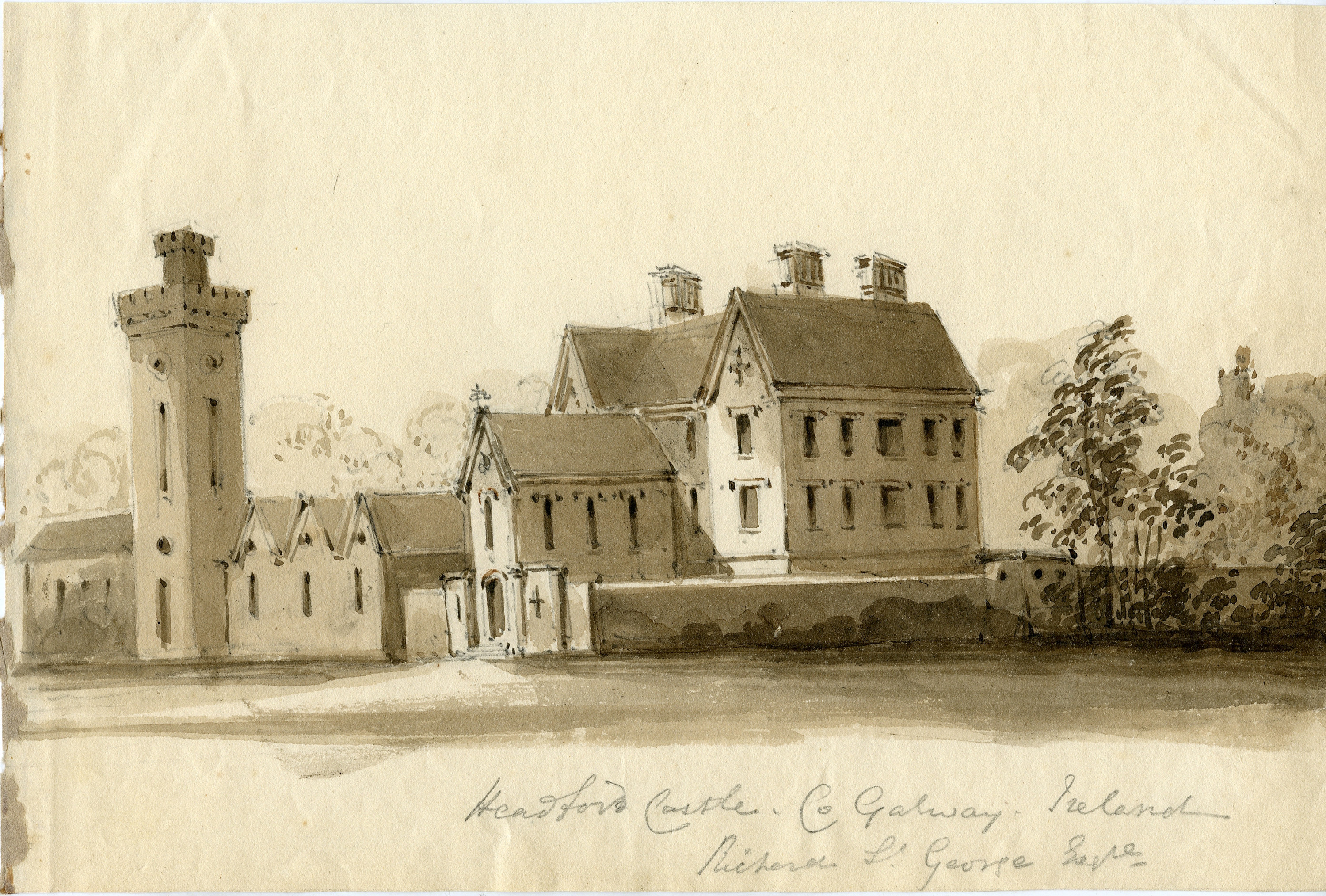

Two views of Headford Castle, Co. Galway c.1828 by Richard St George Esq. Images courtesy of James Adam and Sons Ltd.
1833
On 18 June, Stepney St. George marries Fanny L'Estrange, daughter of Col. L'Estrange of Moystown, King’s County (now Co. Offaly).Connaught Telegraph, 29 November 1843, p. 3. ‘Died’. See also: Burke, Sir Bernard (1886) A Genealogical and Heraldic History of the Landed Gentry of Great Britain and Ireland (7th Edition), Vol. II. London: Harrison & Sons, p. 1604. They would have seven children: Richard James (b. 20 October 1838) who would succeed his uncle at Headford Castle), Major Henry Peasley L'Estrange (2nd Batt. Royal Warwickshire Regt.), Sophia Grace (who married T. Heywood Esq.), Frances Jane Edith (who married Edmund John Winn), Stepney Avenel, Arthur Baldwin, and Rev. Herbert Schomberg (who married on 24 May 1870, Flora K. E. Porcelli, grand-niece and adopted child of the Dowager Countess Brownlow). Burke, Sir Bernard (1886) A Genealogical and Heraldic History of the Landed Gentry of Great Britain and Ireland (7th Edition), Vol. II. London: Harrison & Sons, p. 1604; York Herald, 11 April 1863.
1835
An inquiry for the House of Commons into the Conditions of the Poorer Classes in Ireland reported that there were 35 widows living in Headford, 17 of whom lived rent-free and earned their living as lacemakers. It is said that they received 'a good deal of assistance from Mrs. St. George.'House of Commons (1835) ‘Inquiries into the Condition of the Poorer Classes in Ireland’, Appendix (A) and Supplement. London: House of Commons, p. 115. At this time, the mistress of Headford Castle was Elizabeth Sophie St. George (née Shaw).
1836
Richard James Mansergh St. George builds a new Elizabethan-style residence, designed by George Papworth, on the site of the old Headford Castle (see illustration above).National University of Ireland, Galway (2011) 'Landed Estates Database. House: Headford Castle'.
1837
Bobbin lace-making, coarse linen, and flannel are listed as the main industries in Headford.Lewis, Samuel (1837) A Topographical Dictionary of Ireland, Vol. II. London: S. Lewis, p. 4.
Pre-Famine
It is reported that:
Previous to the famine, however, the lace manufacture at Headford was on the decline, and for this simple cause, that the patterns were becoming old-fashioned, and no one was at the trouble of procuring new ones. The creative power of lace makers in general is very deficient. The manufacture is eminently imitative. The patterns are traced and pinholed on parchment, and no scope is allowed for the display of either taste or imagination; and thus the inventive faculties, being never called into exercise, become extinct. [...] Art education for the working classes is what we want in this country [...] in the schools maintained for the instruction of the children of the artisans and peasantry. [...] The pilllow lace trade might, I am confident, be once more established in Headford without difficulty. Every woman in it would willingly lend her aid, and there is a loud imperative call now that we should all unite and exert ourselves for the good of our fellow-country-men and women.Wadge, E. Harvey [Ed.] (1866) ‘The Irish Industrial Magazine’. Dublin: McGlashan & Gill, pp. 204-205.
Mid-1840s
The Parliamentary Gazetteer records linen and woollen manufacture in Headford.Candon, Gerardine (2003) Headford, County Galway, 1775-1901. Dublin: Four Courts.
1842
Richard James Mansergh St. George becomes an absentee landlord of Headford and decides to become a resident of Malta.The Nenagh Guardian, 18 May 1842, p. 1. 'Absenteens'
It is unclear whether his tenure at Headford had been a good one, as reports concerning his incumbency vary wildly. He definitely made efforts to improve horticultural practices on his tenants’ land,The Tuam Herald, 18 December 1841, p. 3. ‘To The Tenants of the Headford Estate’ and an article in the Nenagh Guardian in 1842 says that he was 'admitted by all parties to be the best of landlords'.The Nenagh Guardian, 18 May 1842, p. 1. 'Absenteens' In stark contrast, his heavy-handed response to a local meeting held to appeal the payment of tithes (he stormed into the church where the meeting was held, wielding a sword) prompts an 1832 article in the Connaught Telegraph to describe him as 'a little local tyrant who, however great the curse of absenteeism may be, would confer a blessing on an unhappy peasantry, had he rid them for ever of his torturing presence.'Connaught Telegraph, 31 October 1832, p.1. ‘Extraordinary Tithe [print obscured] Headford – Richard M. St George of Headford Castle’
Richard's brother, Stepney St. George, takes over the management of the Headford Estate.
1843
On 20th November, Fanny St. George, wife of Stepney, died of a fever after giving birth to twin sons, who survived.Freemans Journal, 29 November 1843, p. 4. ‘Deaths’
1845
The Illustrated Record & Descriptive Catalogue of the Dublin International Exhibition of 1865 recounts that:
During the autumn of 1845 the writer passed through the little town. It was then like a hive of bees in summer, full of joy and activity, and the hum and noise of industry. At some of the cottage doors were groups of neatly-dressed young girls, seated on low stools, their lace pillows on their laps; and while their fingers moved rapidly through the maze of bobbins, their voices filled the air, if not with melody, at least with heart music. Farther on might be seen a couple of elderly women, whose hands had not yet forgotten their cunning, working out intricate, if not very graceful patterns; or perhaps a young mother seated within the doorway, her foot gently moving a cradle, while her fingers plied their busy task.Parkinson, Henry & Lund Simmonds, Peter [Eds.] (1866) ‘The Illustrated Record & Descriptive Catalogue of the Dublin International Exhibition of 1865’. London: E. and F. N. Spon, p. 273.
1846
The Great Famine was starting to take a severe toll on the town of Headford. The same writer as the 1845 report now declares that 'In about a year afterwards all this was changed. The young lace-makers fled away from the disease and destitution which followed on the failure of the potato crop. […] The [merchants’] travellers ceased to visit the place, and now it contains amongst its inhabitants but a few regular lace-makers, though a slight knowledge of the art is very generally known.'Parkinson, Henry & Lund Simmonds, Peter [Eds.] (1866) ‘The Illustrated Record & Descriptive Catalogue of the Dublin International Exhibition of 1865’. London: E. and F. N. Spon, p. 273.
1847
Richard James Mansergh St. George did not live at Headford castle at this time, so it was his brother, Lieutenant Stepney St. George, who managed the family's estate at Headford during the Famine. He wrote regularly to Dublin Castle requesting boilers in order to establish a soup kitchen for his tenants. Ïn a letter dated 22 April 1847, he pleaded: 'Send us immediate relief. [...] Otherwise nothing can save thousands from dying; even this very day I have seen several persons actually die in the streets of this small village and fever is commencing its attack on us.'Tribune Life, 11 November 2005. 'History-laden canoe comes down from its lofty perch' by Christina McDonald Legg.
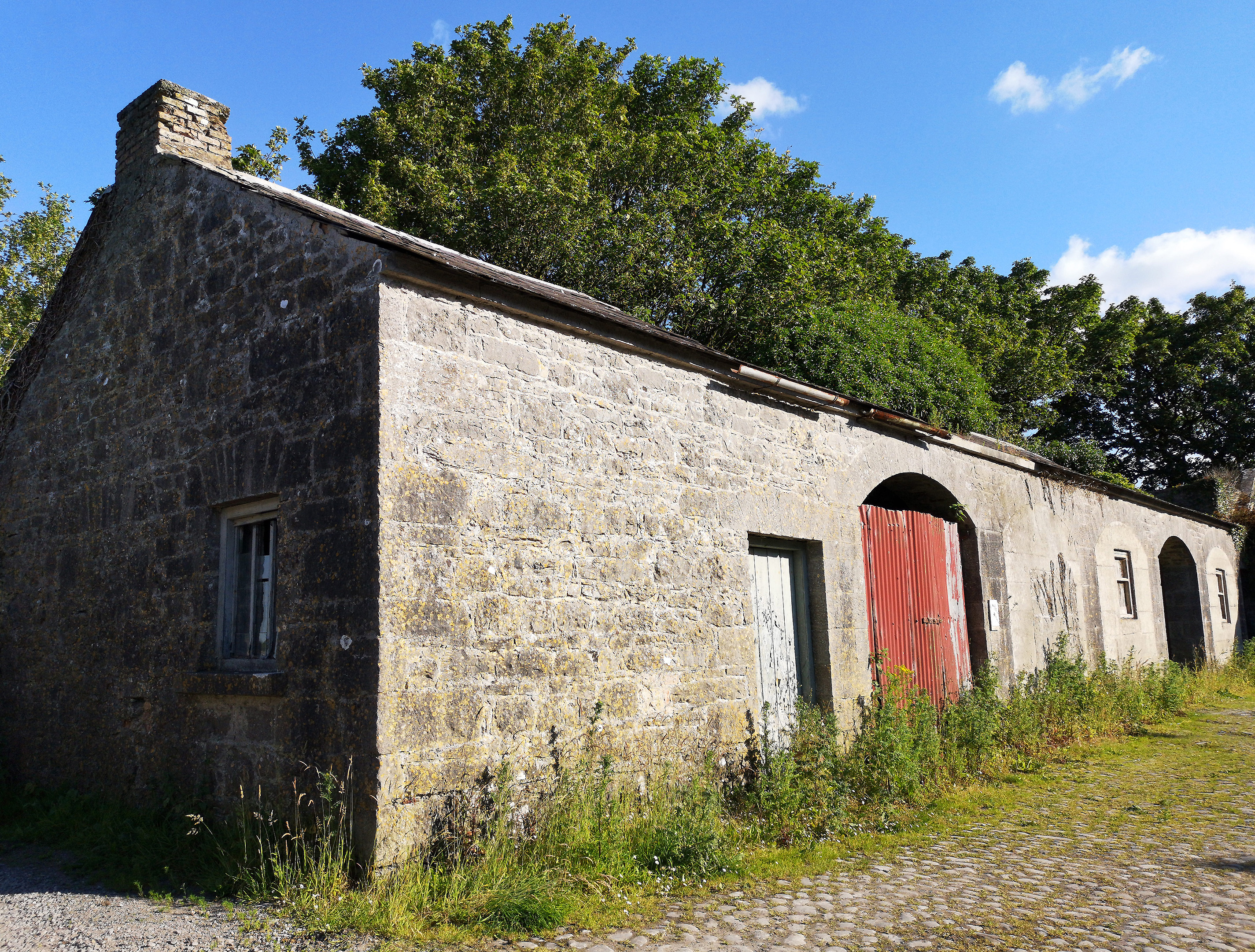
Farm buildings on the Headford Estate (off Bridge Street) in which Stepney St. George established a soup kitchen during the Great Famine.
Stepney himself died in 1847 of the fever, which was then ravaging the area.O'Byrne, Robert (2017)Tyrone House and the St. George Family: The Story of an Anglo-Irish Family. Bloomington, Indiana: Xlibris, p. 40. Stepney’s wife had predeceased him (1843) and their son still a minor, so Headford castle and estate was managed by an agent (see below).
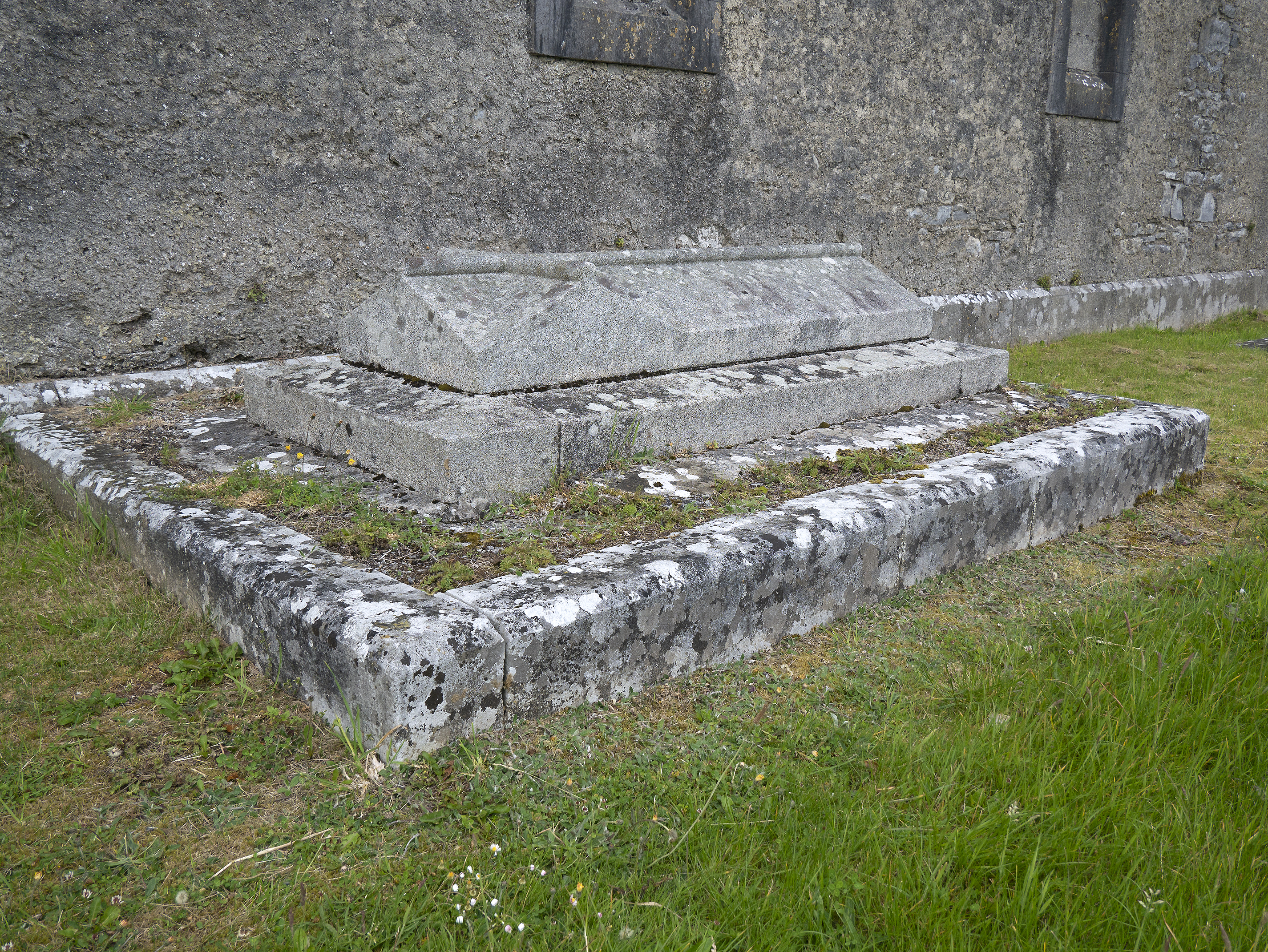
St. George grave at the White Church in Headford. Stepney St. George (17 March 1791 - 21 May 1847), his wife Frances (died 22 November 1843), and their son Richard James St. George (20 October 1838 - 2 June 1889) are buried here.Burke, Sir Bernard (1886) A Genealogical and Heraldic History of the Landed Gentry of Great Britain and Ireland (7th Edition), Vol. II. London: Harrison & Sons, p. 1604. See also: Brigid Clesham, archivist, in a talk at the Headford Community Orchard on 19th August 2018.
Click here to see our photogrammetric analysis of the St. George gravestone.
It can be seen that, despite the ravages of the Famine, lacemaking helped to sustain the local population. A Board of Works report states that 'A good deal of lace is manufactured in this country: in the small town of Headford there are several hundred people engaged in it; from want of a market it is bought by pedlars at a very low rate, and carried to other parts of the country at a very low price, that one would scarcely think paid for the material it was made of.'Board of Works (1847) ‘Correspondence From January to March 1847 Relating to The Measures Adopted for the Relief of the Distress in Ireland. Board of Works Series. Second Part. Presented to both Houses of Parliament byCommand of Her Majesty', published in Accounts and Papers: Thirty-Seven Volumes. Relief of Distress (Ireland): Board of Works, Part II. Commissariat, Part II. Session 19 January - 23 July 1847. Vol. LIII. London: W. Clowes and Sons, p. 210.A remark added to the report by Sir R. Routh states that 'Lace from Galway, Limerick, and other parts of the Irish western district, goes largely into the English trade.'Board of Works (1847) ‘Correspondence From January to March 1847 Relating to The Measures Adopted for the Relief of the Distress in Ireland. Board of Works Series. Second Part. Presented to both Houses of Parliament byCommand of Her Majesty', published in Accounts and Papers: Thirty-Seven Volumes. Relief of Distress (Ireland): Board of Works, Part II. Commissariat, Part II. Session 19 January - 23 July 1847. Vol. LIII. London: W. Clowes and Sons, p. 209. What is interesting to note here is that, despite the decline, there are still 'several hundred' people working in the lace industry in Headford. However, the low prices offered for lacework would continue to be a serious issue for the industry in the coming decades.
Shortly before his death, Stepney St. George had written a letter to the Queen Dowager, Adelaide, pleading the case of Headford's lacemakers, and received a remittance of £20 in response.Dublin Evening Mail, Wednesday, 17 February 1847, p.3.. Less than a fortnight later, Queen Victoria followed the example of her aunt and she also placed an order for twenty pounds worth of Headford Lace. Westmeath Independent, Saturday, 27 February 1847, p.2.
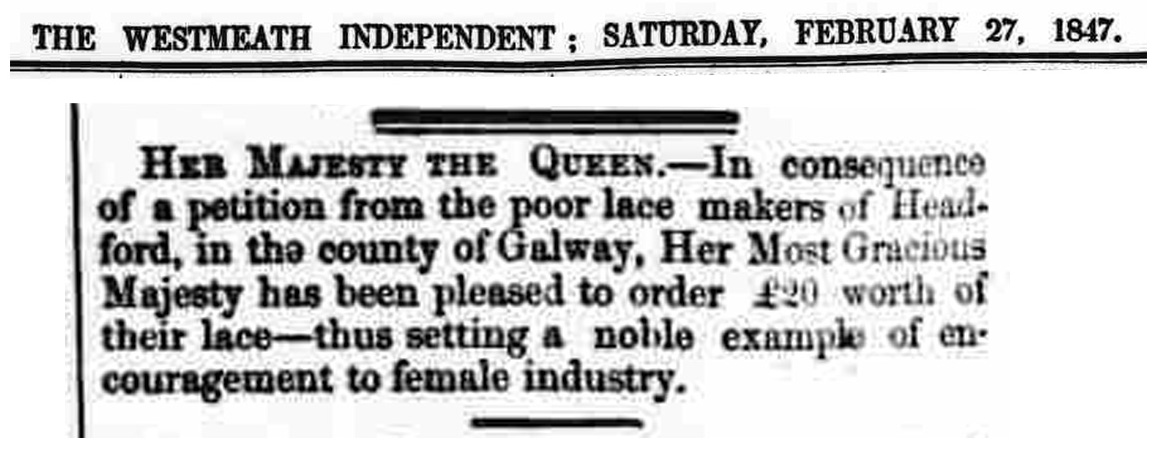
Image courtesy of the Westmeath Independent via the British Newspaper Archive
Using the price paid by Lady Clonbrock for Headford Lace in 1870 (see below),Clonbrock Estate Papers: Ms 35,733 (9). Clothing account book, June 1868-Dec 1872. National Library of Ireland. we can estimate that the queens' investment could have purchased almost TWO MILES of lace. Not only did Queen Victoria's investment provide a huge boost to the industry, but the fact that the queen had purchased Headford Lace would have increased demand for it. Queen Victoria was the social media influencer of her time! As we have seen, her purchase was publicised in newspapers, thereby incentivising ladies of the upper classes to likewise make purchases of Headford Lace.
Click here to read more about the queens' purchase of Headford Lace.
1849
In the winter of 1836-37, a new Church of Ireland curate was appointed to Headford by the Archbishop of Tuam. This was Rev. William Jackson (c.1809-1885) from Mayo, who had graduated with a B.A. from Trinity College Dublin in 1830 at the age of twenty one.Trinity College Dublin (1935) Alumni Dublinenses : a register of the students, graduates, professors and provosts of Trinity College in the University of Dublin (1593-1860). Dublin: Trinity College Dublin, p. 434. The then Archbishop, the Honorable and Most Reverend Power Le Poer Trench, wrote a letter on November 28, 1836 in which he stated that he was moving the young curate from the parish of Feenagh, Co. Leitrim, because he was 'much wanted at Headford'.D'Arcy Sirr, Rev. Joseph (1845) A Memoir of the Honorable and Most Reverend Power Le Poer Trench, Last Archbishop of Tuam.Dublin : W. Curry, p. 410. Rev. Jackson is subsequently recorded living at Headford in 1837Lewis, Samuel (1837) A Topographical Dictionary of Ireland comprising the Several Counties, Cities, Boroughs, Corporate, Market, and Post Towns, Parishes, and Villages, with Historical and Statistical Descriptions, Vol. I. London: S. Lewis, p. xxxvi. and again in 1846Slater, I (1846) National Commercial Directory of Ireland. Manchester & London: I. Slater, p. 128.. He married Julia de Villiers in Headford on 30 June 1847.General Register Office, Ireland (1847).Register of Marriages in the District of Tuam. Returns Year: 1847. Returns Quarter: 1. Returns Volume No: 10. Returns Page No. 477.Two years later, Rev. Jackson was promoted to a position as Vicar of the Union of Templemore in Co. Tipperary. On that occasion, a letter was published in the The Tuam Herald on 25 August 1849. It congratulates Rev. Jackson on his promotion and praise his 'constant urbanity of manner towards all classes, and the diffusion of an unobtrusive charity to the poor of this town and neighbourhood, without distinction of creed'. It furthermore recognises Mrs. Julia Jackson for her work in reviving the lace industry in Headford. It says:
In Mrs. Jackson, the poor of Headford and the surrounding district will have lost a most humane and active friend, and her untiring exertions in the cause of general charity, and in particular, her successful efforts to revive our hitherto neglected lace manufacture, have, we trust, by giving wholesome stimulus to industry, and opening a future and remunerative market for the production of our poor and well-conducted female population engaged in this trade, laid the foundation of a continual demand upon their labours, which will long survive her regretted removal from among us.Tuam Herald, 25 August 1849, p. 3. 'Address to the Rev. William Jackson, Vicar of the Union of Templemore, and Late Curate of Headford'.
Julia Jackson died on 23 July 1863, and she is buried in the Church of Ireland cemetery in Foxford, Co. Mayo.Julia (de Villiers) Jackson's headstone, beside the CoI church in Foxford is incribed as follows: 'TO THE MEMORY / OF / JULIA / NEE DE VILLIERS, / BELOVED WIFE OF THE / VEN. WILLIAM JACKSON M.A. / ARCHDEACON OF KILLALA / AND VICAR OF STRAID, / WHO ENTERED INTO REST / 23RD JULY 1863. / "THEM ALSO WHICH SLEEP IN / JESUS WILL GOD BRING WITH / HIM." / I. THESS. IV.14' Rev. Jackson remarried to Susan Anne Kenny of Ballinrobe in St. Stephen's Church in the Parish of St. Peter in Dublin on 11 April 1866.St. Stephen's Church Records, Parish of St. Peter, Dublin (1866).Register of Marriages, p. 43, Entry No: 86. Available at IrishGenealogy.ie, accessed 13 May 2019. Rev. Jackson goes on to become Dean of Killala in Mayo from 1872Not to be confused with William Oliver Jackson, who was Dean of Killala 1903-1904. until his death at Kilanley, Castleconnor, Co. Sligo (where he was also the incumbent) on 04 August 1885.Church of England (1885)Crockford's Clerical Directory for 1885. London: Horace Cox, p. 636.
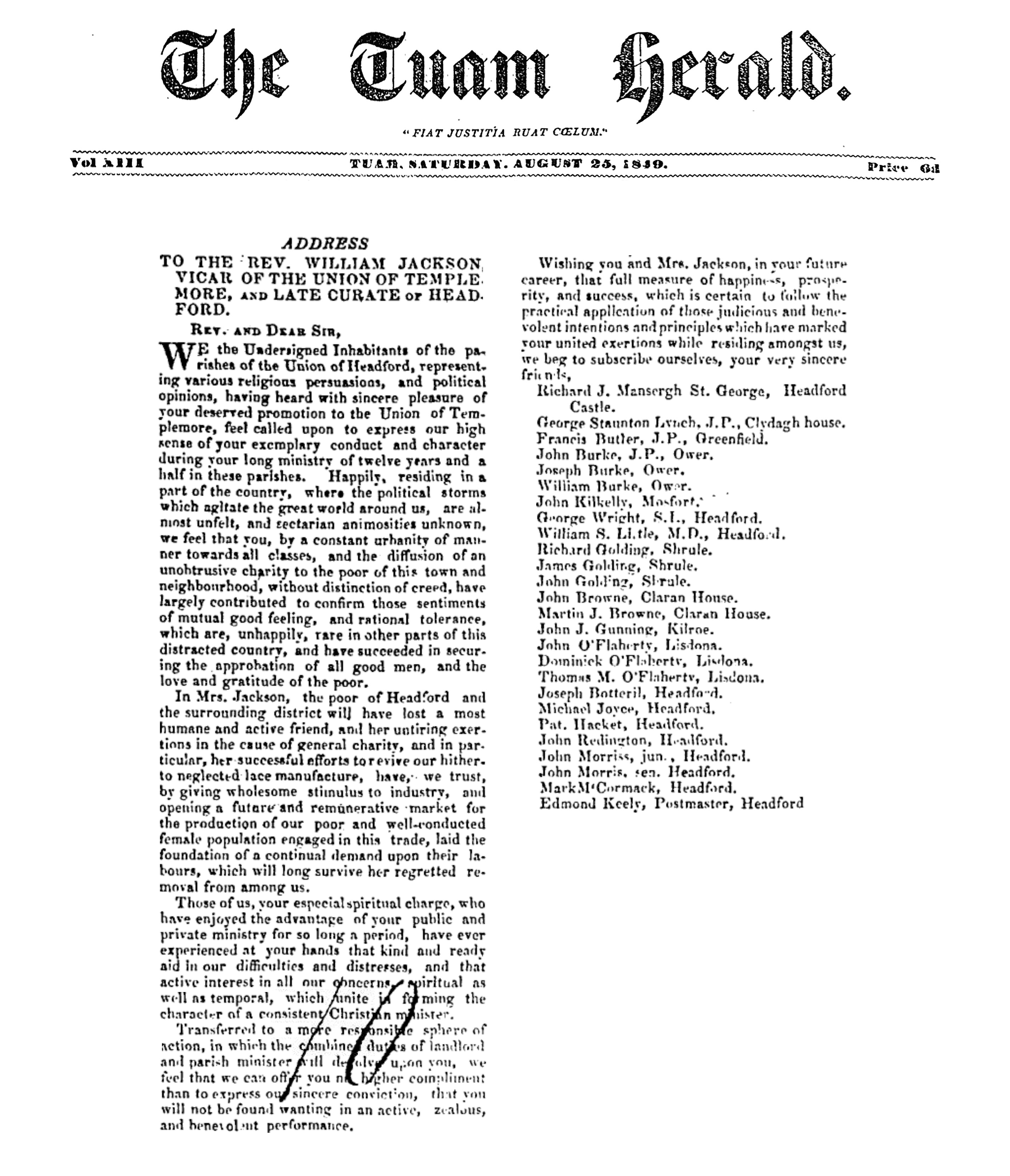
Image courtesy of The Tuam Herald
1852
Nineteen paupers left via Nenagh to catch the train to Dublin en route to America. 'They were sent out by R. M. St. George, Esq., of Headford Castle, to whose property they originally belonged. Mr. St. George very humanely gave each emigrant a sum sufficient to support him for a time after his arrival in America.'The Nenagh Guardian, 26 May 1852, ‘Pauper Emigration’, p. 1. This was known as assisted emigration, and it became popular with Irish landlords because it was cheaper to export people from their estate than to support them under the Irish Poor Law Act of 1838.
Also in 1852, the Ladies’ Irish Industrial Society opened a branch of the Normal Lace School in Headford. The Normal Lace School had been established two years prior in Dublin, and was now being extended to various parts of the country 'under the patronage and generally at the sole expense, of individuals who became the medium of introducing the work to the market by their own personal exertions'.Meredith, Susanna (1865) The Lacemakers: Sketches of Irish Character with some account of the Effort to Establish Lacemaking in Ireland. London: Jackson, Walford, and Hodder, pp. 372-373. The patron in Headford is listed as a Mrs. Hunt. She was Catherine Elizabeth Hunt née Powell, who on 25 March 1851 had marriedWhite, Colonel James Grove (1913)Historical and Topographical Notes, Etc. on Buttevant, Castletownroche, Doneraile, Mallow And Places in their Vicinity, Vol. III. Cork: Guy and Co. Ltd., p. 8. the St. George's land agent,St. George, Richard James Mansergh (1857) 'Will of Richard James Mansergh St George of Headford Castle, Galway'. Available at The National Archives, Kew. Reference: PROB 11/2252/46. Edmund Lombard HuntEdmund Lombard Hunt is the man who donated a First Nation canoe to the University of Galway. It had been brought back from New Brunswick, Canada, by Stepney St. George in 1825 after serving in the British Army there. It hung in the Quadrangle at the university in Galway for 153 years before being repatriated to the Maliseet people in 2013. (1801-1860). The Mansergh family had ceased residing at Headford Castle after the death of Stepney St. George during the Great Famine.Tribune Life, 11 November 2005. 'History-laden canoe comes down from its lofty perch' by Christina McDonald Legg. Unfortunately, local accounts of Mr. Hunt's management of the estate at Headford are very unfavourable. Dr. Kathryn Moore claims that 'In December of 1850 many houses were levelled within a mile of Headford town on the estate that Hunt had taken over, undoing the good deeds of the St. George family'.Tribune Life, 11 November 2005. 'History-laden canoe comes down from its lofty perch' by Christina McDonald Legg. From May 1855 comes the following report: '"Fifteen houses were levelled on the property of Mr. St. George on Thursday last and the greater number of these poor people had paid, and the remainder were willing to pay all arrears. Amongst the evicted, a poor child in fever was thrown upon the dunghill in bitter cold." Locals say the evictions were carried out in Keernaun by Mr. Hunt.'Galway County Heritage Office (2017) 'The History of Headford'. Whatever the actions of her husband, Mrs. Hunt certainly advocated for the people of Headford through her patronage of the lace school. Unfortunately, her efforts were ultimately in vain. Meredith notes that 'Connected with this failure there is a very remarkable fact to be noticed, and it is that the lace did not fail to be demanded, but that it failed to be produced. The workers never were content with the remuneration offered them'.Meredith, Susanna (1865) The Lacemakers: Sketches of Irish Character with some account of the Effort to Establish Lacemaking in Ireland. London: Jackson, Walford, and Hodder, pp. 373-374. It should be recalled that the low price paid for their work was a constant challenge for Headford lacemakers throughout the nineteenth century.
1859
Richard James Mansergh St. George dies. Headford Castle is inherited by his brother's eldest son, Richard James St. GeorgeO'Byrne, Robert (2017)Tyrone House and the St. George Family: The Story of an Anglo-Irish Family. Bloomington, Indiana: Xlibris, pp. 40-41.(c.1838-1889).
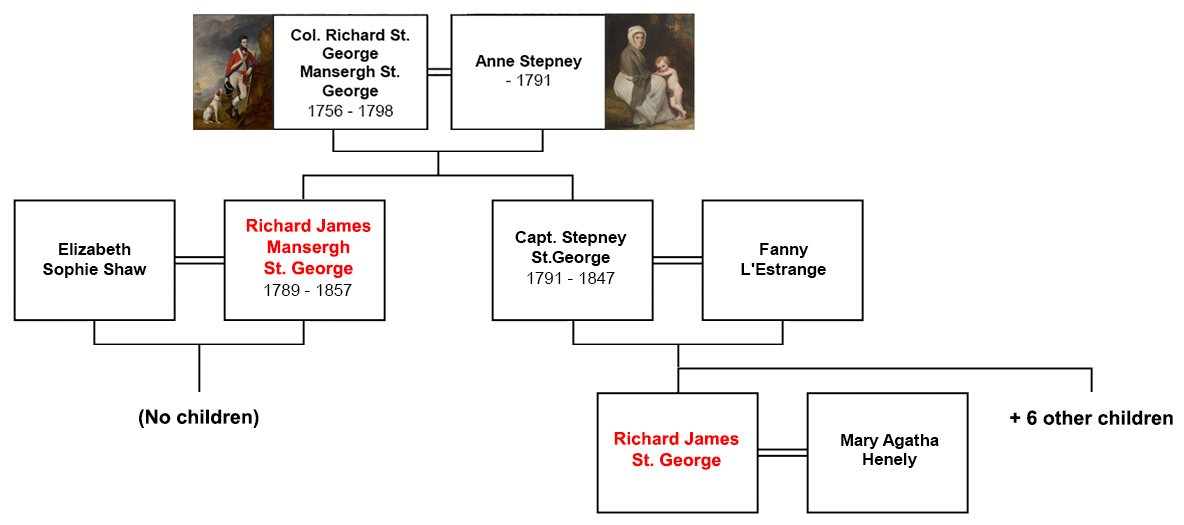
1860
Richard James St. George marries Mary Agatha, eldest daughter of J. Henley Esq. of Liverpool.Burke, Sir Bernard (1886) A Genealogical and Heraldic History of the Landed Gentry of Great Britain and Ireland (7th Edition), Vol. II. London: Harrison & Sons, p. 1604.
1861
A visitor to Headford describes:
Headford, an exceedingly well-ordered little town, where we certainly came up with both lore and lay, the latter being chanted by the neat peasant girls that sat at the doors lace-making, while the lessons in the art we for the first time received was lore of a kind so entertaining; we were very glad to be allowed to make purchases from their after hour’s manufacture of the very pretty cushion lace, to make presents of in our own less industrious part of Ireland, where Cowper's appropriate lines would always remind us pleasantly of our entrance into Headford, where sits the
Cottager, who weaves at her own door,
Pillows and bobbins all her little store;
Content, though (poor) and cheerful, if not gay,
Shuffling her threads about the live-long day,
Just earns a pittance and at night
Lies down secure, her heart and pocket light.Anonymous (1861) Ierne: Or, Anecdotes and Incidents During a Life Chiefly in Ireland' by a Retired Civil Engineer. London: Partridge and Co., p. 222.
1864
Mr. Corrigan is named as the Steward of Headford Castle.Tuam Herald, 03 September 1864, p. 2. ‘Horticulture’
1869
The lace school 'of the St. George family, at Headford, Co. Galway' is mentioned in A History of Lace by Mrs. Fanny Bury Palliser.Bury Palliser, Fanny (1865) A History of Lace. London: Sampson, Low, Son, and Marston, p. 416. The same entry appears on p. 385 in the 1869 edition and on p. 394 in the 1875 republication.
1870

Image courtesy of the National Library of Ireland
Previous records reported that most Irish lace was sold on the English market. However, there is also evidence of it staying in the country where a patron of means could be found. The Dillon family of Clonbrock House, near Ahascragh in East Galway, were such patrons. Lady Augusta Caroline Dillon née Crofton (1839-1928), wife of the 4th Baron Clonbrock, Luke Gerald Dillon (1834-1917), had a keen interest in promoting women's industries. In her clothing account book dated to the middle of 1870, there is a record of a purchase of interest: '8 yds Headford Lace' for which she paid two shillings.Clonbrock Estate Papers: Ms 35,733 (9). Clothing account book, June 1868-Dec 1872. National Library of Ireland. This purchase price gives us an indication of the low wages that would have been received by the lacemakers. What is also of interest is what was purchased alongside the Headford Lace, which includes '2 yds of elastic 4 (8d), 1 Stay Lace & 6 Buttons (1s 6d)'Clonbrock Estate Papers: Ms 35,733 (9). Clothing account book, June 1868-Dec 1872. National Library of Ireland. and suggests that the Headford Lace was used to trim an undergarment.
Most importantly, however, this entry in Lady Clonbrock's clothing account book is the first known reference to Headford Lace as a typonomic term associating its production with the Headford area.
1874
'The extravagances of the owner of Headford Castle considerably crippled his resources and caused the compulsory surrender of many thousand of the estates most fertile acres' and the estate was put up for sale through the Landed Estates Court in 1874 and sold in 38 lots in 1876. The Castle, town and some of the lots were not sold.Galway County Heritage Office (2017) 'The History of Headford'.

The State of Ireland: Women Carrying Home Meal-Sacks from the Relief Committee. A Sketch near Headford, by our special artist. Published in Illustrated London News, 20 November 1880. Image courtesy of Mary Evans Picture Library.
1885
A bobbin factory is recorded in Headford.Great Britain. Parliament. House of Commons. Select Committee on industries (Ireland). (1885). Report from the Select committee on industries (Ireland): together with the proceedings of the committee, minutes of evidence and appendix. London: Printed by H. Hansard and Son. The precise type of bobbins is not mentioned, but it is compared to the factory in Tuam, which manufactured 'fittings such as bobbins, reels and spools for cotton and woollen mills.'Claffey, J.A. (2009) Irish Historic Towns Atlas, no. 20, Tuam. Dublin: Royal Irish Academy, p. 8. It is likely, therefore, that the bobbin factory in Headford was also supplying the weaving industry; quite likely in addition to the lacemaking industry.
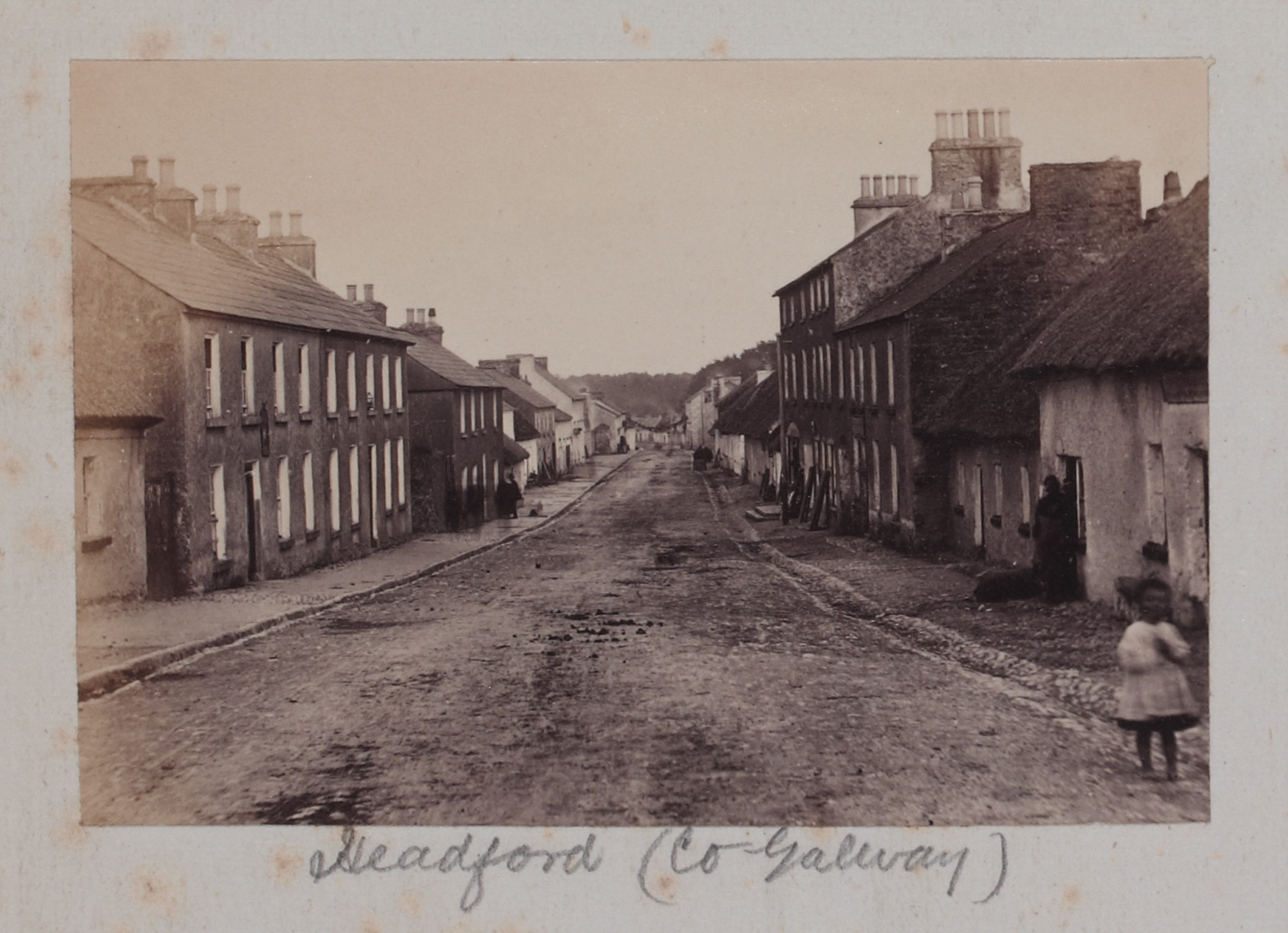
Main Street, Headford in 1880. Photographed by Thomas J. Wynne. Image courtesy of the National Library of Ireland.
1887
The Royal Jubilee Exhibition, held in Manchester, included a section on 'Women's Industries'. The catalogue describes entries in various mediums, including Youghal Lace, Carrickamacross Lace, Limerick Lace, and Mountmellick work - well known types of Irish lace and needlework.Other less well-known laces mentioned include Parsonstown Lace and Birr Lace. Alongside these exhibits is the following listing: 'Mrs. Burke, Omer [Ower]The catalogue records Mrs. Burke's address as Omer, but we believe this to be a misspelling of Ower, a townland just outside Headford. Headford, Co. Galway - Headford Lace.'Royal Jubilee Exhibition (1887), 'Royal Jubilee Exhibition, Manchester 1887: Official Catalogue' Manchester: JohnHeywood, p. 221. This suggest that Headford Lace was recognised in its own right, as it was recorded distinct from other instances of 'torchon lace' recorded in the same catalogue.
1889

Headford Castle. Photograph courtesy of Dr. Patrick Melvin & Éamonn de Búrca
Richard James St. George dies aged 51 yearsGeneral Register Office, England (1889)England and Wales Death Registration Index 1837-2007. Year: 1889; Volume: 2A; p. 135. on 02 June 1889 at 181 Anerly Road, Anerly in Surrey, England.The National Archives of Ireland,Calendars of Wills and Administrations 1858-1920:1889, p. 680 His widow, Mary Agatha St. George (née Henely) - who had since remarried in Kensington to Jerome Feliza TrudonGalway County Heritage Office (2017) 'The History of Headford'. See also: England and Wales Marriage Registration Index (1837-2005). Jerome Feliza Trudon, marriage, 1892, quarter 2, vol. 1A, p. 331. Accessed 19 September 2019. - sold Headford Castle in 1892 to Martin McDonnell, a merchant from Dunmore.Galway County Heritage Office (2017) 'The History of Headford'. There ended the St. George patronage of the lace industry in Headford, but the lace industry lived on for some time afterwards.
The National Museum of Ireland - Decorative Arts & History at Collins Barracks in Dublin have in their collection seven specimens of 'pillow lace, made at Cong, Co. Galway, c.1889. Presented by Mrs. Dawson.'National Museum of Ireland. DT:1889.459-DT.1889.465. Seven specimens of pillow lace, made at Cong, Co. Galway, c.1889. Presented by Mrs. Dawson. In 1902, Mrs. Martha Dawson was also credited with reviving the lace industry in Headford at the end of the nineteenth century.Bury Palliser, Fanny;Jourdain, Margaret and Dryden, Alice (Eds.) (1902) A History of Lace. New York: Charles Scribner's Sons, pp. 445-446. The examples of lace from Cong in the National Museum provide a valuable resource for contemporary lacemakers who are working to research and revive the lace heritage of the locality.
Martha was assisted in her endeavours by Miss Alice Jane Elwood (c.1851-1919) of Lackafinna, Cong. Alice herself was a noted lacemaker in her own right, winning a bronze medal at the Royal Dublin Society in 1889.Horowitz, Janet & Stark, Myra [Eds.] (1890) 'Irish Torchon Lace', published in Irish Textile Jounal. London: Routledge.
1890
Bridget Hogan, a lacemaker from Headford, dies aged 57 at Ballinasloe on 15 November. Like many lacemakers, she was an unmarried woman, and had most likely supported herselft through lacemaking.General Register Office, Ireland (1891).Register of Deaths in the District of Ballinasloe. Returns Year: 1891. Registrar's District: Creagh in the Union of Ballinasloe in the County of Roscommon. Group Registration ID: 3734009. Our thanks to Kay O'Dwyer for this information.
1894
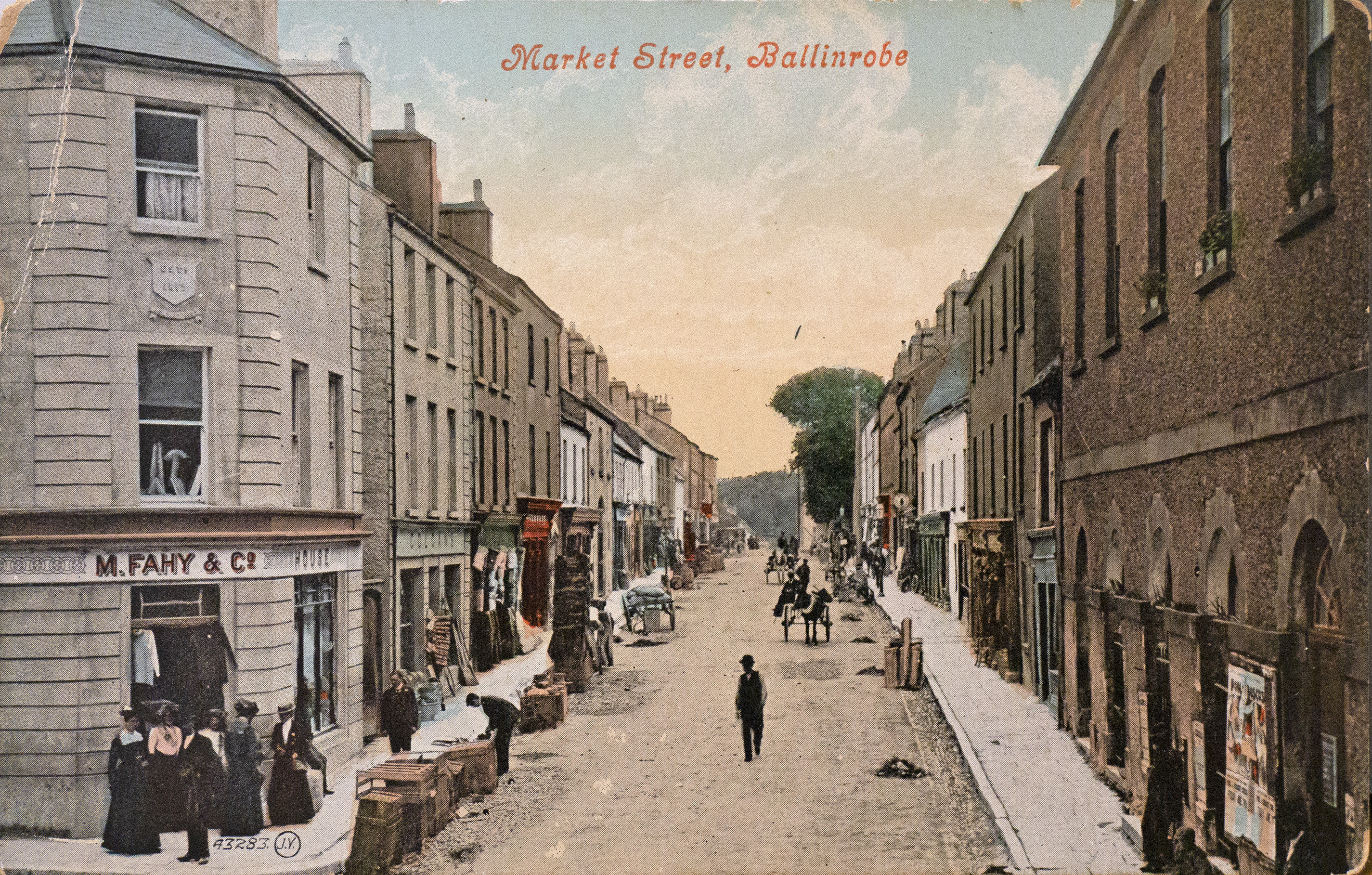
Fahy's shop on Market Street (now Main Street), Ballinrobe. Image courtesy of Mayo County LIbrary.
'A piece of Headford prize lace' was offered by a Mrs. Fahy as a prize in the Annual Bazaar in aid of The Sisters of Mercy in Ballinrobe.Chronicle, 14 July 1894, p. 1. 'Convent of Mercy, Ballinrobe, Annual Bazaar'.The same piece also ran in the Ballinrobe Chronicle on 09 August 1894 (p. 6) 06 September 1894 (p. 4), and 22 September 1894 (p. 4). This was most likely Mrs. Ellenor Fahy, who is shown in the 1901 census records living in Ballinrobe. She was the wife of a general merchant, and they lived above their shop on Main Street (previously called Market Street) with several live-in shop assistants and milliners.Census of Ireland (1901) Residents of a house 14 in Main Street (Ballinrobe, Mayo). National Archives of Ireland. Additional information regarding the shop provided by Ray Hughes.
1901

Catherine Parker née Burke was known as a lacemaker by her family. This photograph was presented by her great granddaughter, Brega Webb.
The Census of Ireland in 1901 records five lacemakers living in the Headford area. They are:
Sarah Walsh - (single) aged 61, Ower, Killursa, Headford - LacemakerCensus of Ireland (1901) Residents of a house 22 in Ower (Killursa, Galway). National Archives of Ireland.
Anne Hogan - (widow) aged 63, New Street, Headford – HousekeeperCensus of Ireland (1901) Residents of a house 8 in New Street (Headford, Galway). National Archives of Ireland.
Margaret Higgins - (married) aged 36, New Street, Headford – No occupationCensus of Ireland (1901) Residents of a house 13 in New Street (Headford, Galway). National Archives of Ireland.
Julia Casey - (single) aged 23, New Street, Headford - No occupationCensus of Ireland (1901) Residents of a house 16 in New Street (Headford, Galway). National Archives of Ireland.
Margaret Casey - (single) aged 24, New Street, Headford – No occupationCensus of Ireland (1901) Residents of a house 16 in New Street (Headford, Galway). National Archives of Ireland.
Catherine Parker - (married) aged 50, High Street, Headford - No occupation Census of Ireland (1901) Residents of a house 45 in New Street (Headford, Galway). National Archives of Ireland.
The difficulty with such records, however, is that if the woman was married, she would usually be listed either as having no occupation. It is only if the woman were unmarried or widowed that her occupation would be recorded. Therefore we can conclude that there were many more lacemakers living in the area in the early twentieth century than the records actually show. In fact, if we look at the above listings, only one of the ladies, Sarah Walsh, is actually listed as a lacemaker; the other ladies are known as lacemakers from other historical records.
1904

The only known example of Headford Lace is believed to date from 1904. It came from the last family to live in Headford Castle and was given by Mrs. Mary McDonogh of Moyne Hill, Headford, to Sandra Joyce, a local crochet teacher, who in turn loaned it to the Headford Lace Project.
1906
The Presentation order of Catholic nuns arrived in Headford. A house they called St. Joseph's was used for night classes for women and older girls. A woman who was insensitively known locally as Cáit Bodhar ('Deaf Kate') helped with crochet and lace-making.McNamara, Margie (2015) 'The Presentation Sisters in Headford' in Headford Parish Church Committee (eds.) Roots of Faith: A Journey of Hope. Tuam: Typestyle, p.66.
In the same year, Headford Castle was burned to the ground in an accidental fire:
Headford Castle, the baronial residence of our very popular and much esteemed neighbour, Thomas A McDonogh, Esq, was accidentally burned down on the night of Saturday last, the 23rd instant. The fire is reported to have originated in the nursery of the Castle, and was not perceived until the flames had almost reached the roof, when it became impossible to cope with it effectively, and notwithstanding the great effords made to suppress it, the entire building was soon burned to the ground. Happily no life was lost, although some providential escapes are reported to have occurred. Neither the proprietor nor Mrs. McDonogh happened to be at home, at the precise time of the occurrence, but the servants, aided by the police and the townspeople hard by, rendered all the assistance in their power, their exertions were chiefly confined to saving the inmates and portions of the furniture and effects, in which latter they were partially successful. The roof fell in, its weight carrying away all the lower floors in succession, leaving the Castle a mass of smoking ruins, the offices only remaining intact.The Tuam Herald, 30 June 1906, p.2. 'Great Conflagration. Headford Castle Burned Down'
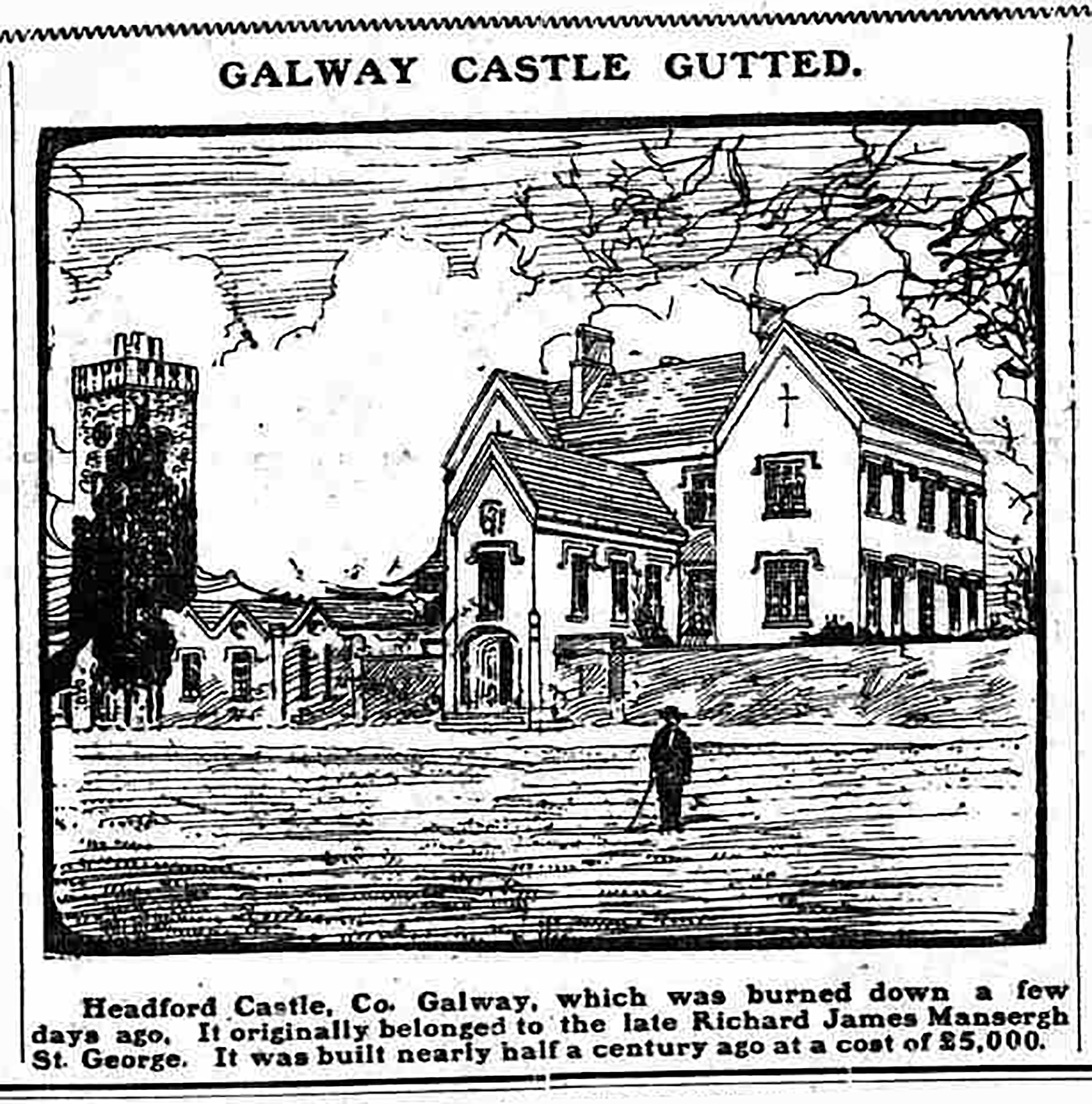
The Irish Independent, Friday, 29 June 1906 (p.7). Courtesy of Independent News & Media via the British Newspaper Archive.
How the fire originated is not very clearly known, but it is considered by some to be due to some defect in one of the flues. It was first noticed about 9:45pm, and in a very short time it was plainly seen that the Castle was doomed. Willing hands were there carrying water and assisting in removing the costly furniture, plate. &c. The lawn in front was soon covered with a miscellaneous collection of different kinds of articles, wardrobes, bedsteads, Dresden china, etc, all intermingled in the hurry and confusion that prevailed in their removal. The greatest credit is due to those who so ably assisted in trying to extinguish the flames, and among these must be specially mentioned Segt McKee, who remained in close proximity to the fire, continually pouring water upon it at the imminent peril of his own life. Constable Murray did more than a man's part also in his own unostentatious way, and certainly Mr McDonogh and Mr McDonnell should feel grateful to these and the townspeople, and bare walls alone are all that now remain of the once stately building, the pride in days gone by of the St George family. I may mention that Lady de Clifford drove from Dalgan Park on Monday to see the ruins. The building was, I understand, partly insured, but the furniture was uninsured, and consequently the greatest sympathy is felt for Mr McDonogh, as several costly articles have been seriously damaged.The Tuam Herald, 30 June 1906, p.2. 'The Burning of Headford Castle'
For many miles around the country was illuminated by flames. Viewed from districts afar the blaze presented the appearance of a monster bondfire, and as it was the eve of the Feast of St. John, it was considered in many places to be merely an observance of the old custom.Western People, 30 June 1906, p. 7. ‘Headford Castle’
These descriptions of the fire at Headford Castle are a sobering reminder of how lucky we are that our sample of Headford Lace survived the conflagration.
1910
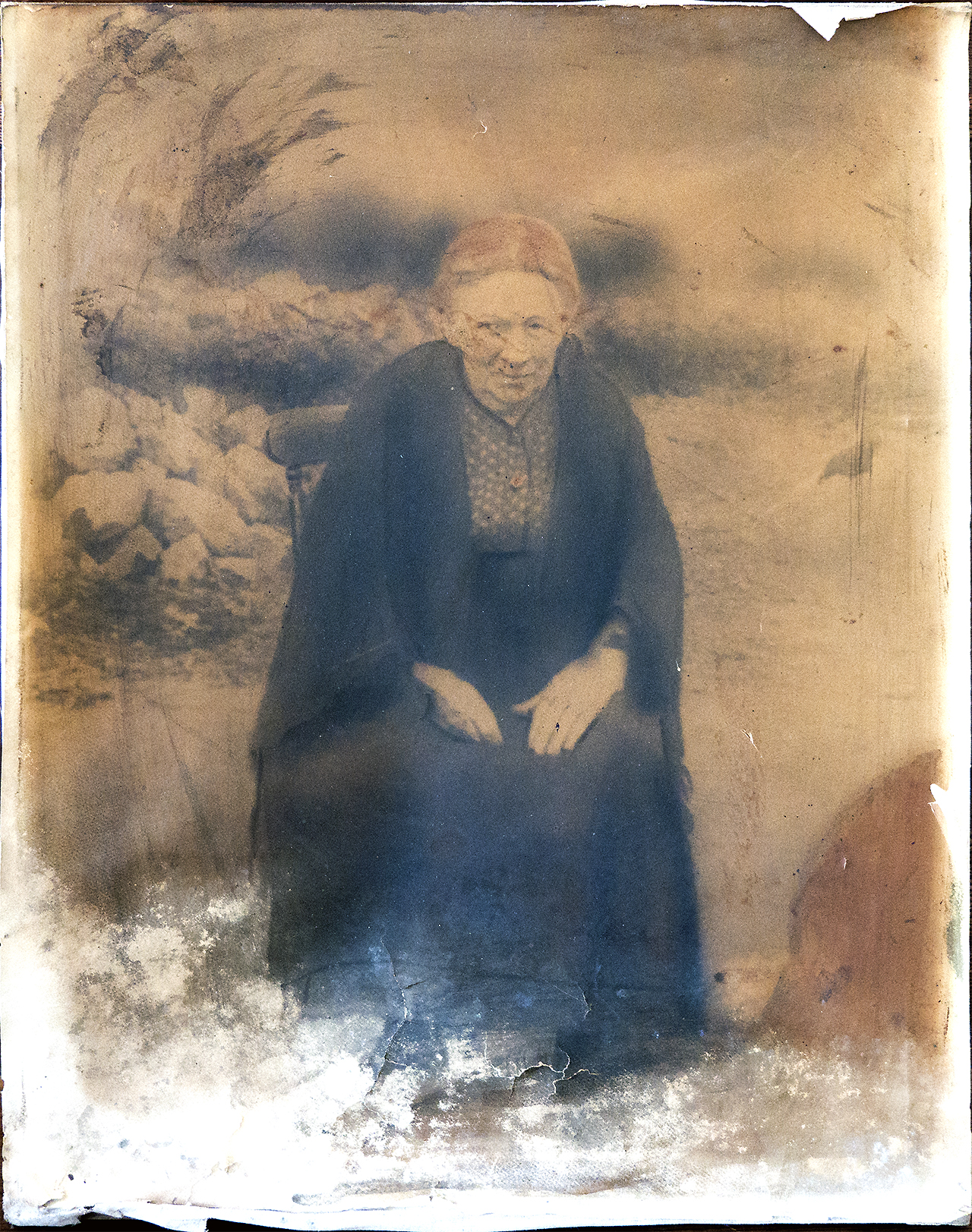
Honor "Nan" Malie, a lacemaker who lived on New Street. She died in 1931 at the age of 108. In 2018, Nora Gildea, a relative who lived at the same house on New Street, described the bobbins found in the house as like pencils, but tapered so that they were thicker at one end. This photograph was kindly donated to the Headford Lace Project by Rita Gildea.
The Headford Agricultural Show includes a category for 'One Piece of Headford Lace, not less than three yards' with prizes awarded. First prize was 5 shillings, and second prize was 2 shillings 6 pence.Headford Agricultural Show (1910) 'Headford Agricultural Show'. Galway: Connacht Champion Printing Works. The entrants were:
Margaret (Mrs. James) Higgins, Headford – one entry
Honor (Miss) Melia, Headford – two entries
Miss M. O’Shaughnessy (Mary?), Headford – two entries (1st place winner)'The Connacht Tribune, 24 September 1910. 'Two Successful Shows'.
Mrs. Anne Hogan, Headford – one entry
Miss Margaret Casey, Headford – one entry
Miss Mary Connell, Headford – two entries (2nd place winner)
Incidentally, Lady Clonbrock (who purchased 8 yards of Headford Lace in 1870) presented the first prize to the winner of the best Home-Made Blouse at the show.'The Connacht Tribune, 24 September 1910. 'Two Successful Shows'.
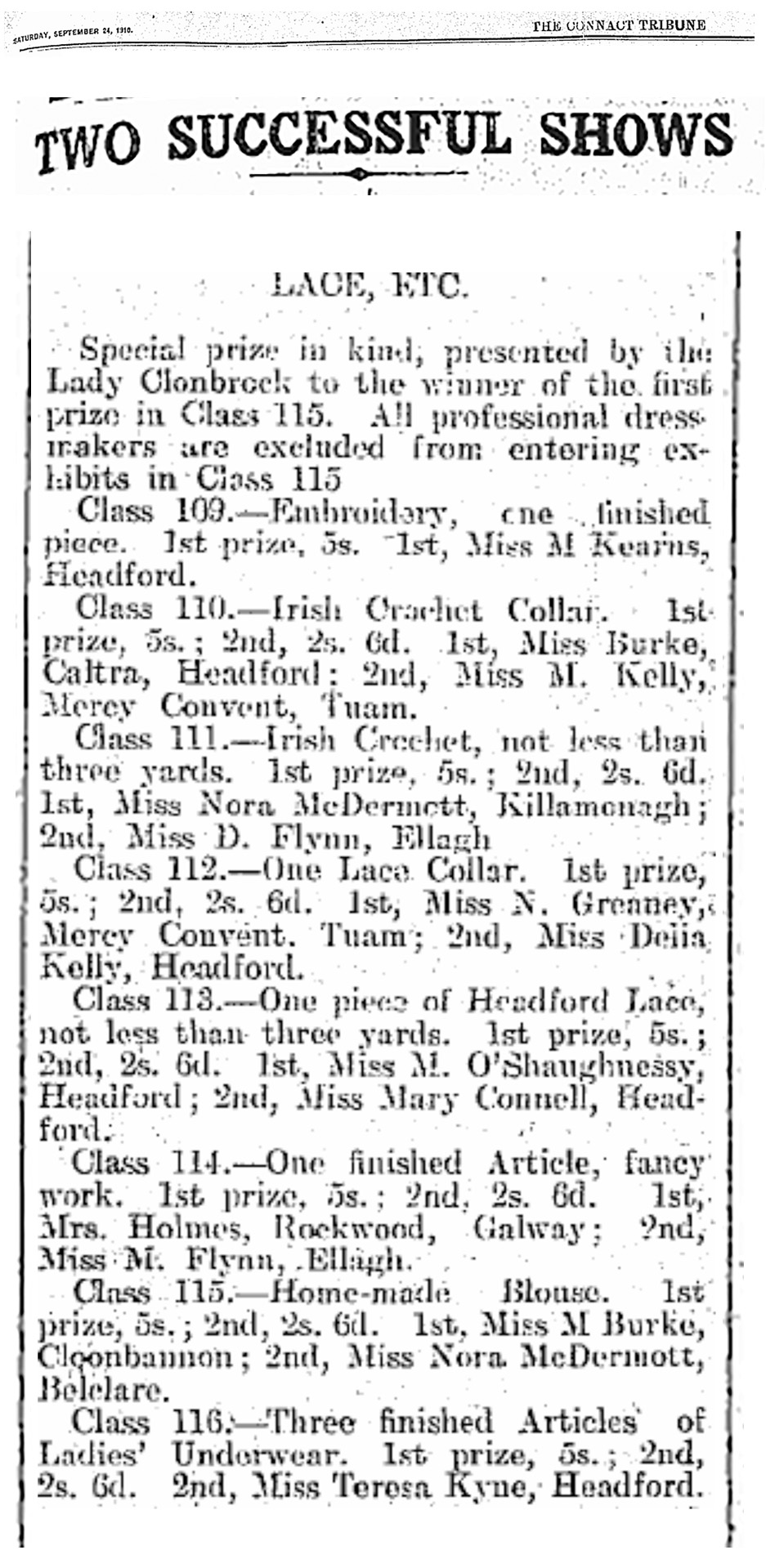
Image courtesy of The Connacht Tribune
1911
The Census of Ireland records the following lacemakers in the Headford area:
Julia Casey - (single) aged 34, Headford - No occupationCensus of Ireland (1911) Residents of a house 1 in Headford (Headford, Galway). National Archives of Ireland.
Margaret Casey - (single) aged 25, New Street, Headford – HousekeeperCensus of Ireland (1911) Residents of a house 12 in New Street (Headford, Galway). National Archives of Ireland.
Mary Burke - (widow) aged 69, New Street, Headford – Lace MakerCensus of Ireland (1911) Residents of a house1 in New Street (Headford, Galway). National Archives of Ireland.
Anne Hogan - (widow) aged 74, Bog Road (now Cong Road), Headford - LacemakerCensus of Ireland (1911) Residents of a house 4 in Bog Road (Headford, Galway). National Archives of Ireland.
Ellen Keane - (single) aged 90, Bridge Street, Headford – LacemakerCensus of Ireland (1911) Residents of a house 15.2 in Bridge Street (Headford, Galway). National Archives of Ireland.
Mary O'Shaughnessy - (single) aged 45, Gortnamona, Headford - Domestic ServantCensus of Ireland (1911) Residents of a house 2 in Gortnamona (Headford, Galway). National Archives of Ireland.
Mary Redington - (single) aged 46, Bridge Street, Headford – House KeeperCensus of Ireland (1911) Residents of a house 16 in Bridge Street (Headford, Galway). National Archives of Ireland.
Margaret Higgins - (married) aged 46, New Street, Headford – No occupationCensus of Ireland (1911) Residents of a house 13 in New Street (Headford, Galway). National Archives of Ireland.
Honor Malie - (single) aged 69, New Street, Headford - No occupationCensus of Ireland (1911) Residents of a house 13 in New Street (Headford, Galway). National Archives of Ireland.
Catherine (Kate) Parker - (widow) aged 56, Bog Road (now Cong Road), Headford - HousekeeperCensus of Ireland (1911) Residents of a house 7 in Bog Road (Headford, Galway). National Archives of Ireland.
In the same year, the Headford Agricultural Show awards prizes for 'One Piece of Headford Lace, not less than three yards'. First prize is 8 shillings and second prize: 4 shillings. Miss Mary O’Shaughnessy won first place, and Miss Margaret Casey won second place.The Connacht Tribune, 16 September 1911, p. 8. 'Headford Show'.
1912
The now renamed Headford Agricultural and Industrial Show again includes a category for ‘Headford Lace’, but the list of prizes awarded shows a decline in the industry. In the category for Lace Collar, no entries were received, and in the Headford Lace category, no prizes were awarded.Western People, 28 September 1912, p. 2. 'Headford Agricultural and Industrial Show'.
1913
The Headford Show again awards prizes for 'One Piece of Headford Lace, not less than three yards. First prize is 8 shillings and second prize is 4 shillings. Miss Mary O’Shaughnessy won first place for the third recorded time, and Miss Mary Redington won second prize.Western People, 04 October 1913, p. 2. 'Headford Show'.
1915
The Headford Show awards prizes for “One Piece of Headford Lace, not less than three yards”. First prize is 8 shillings and second prize is 4 shillings. Miss Mary Redington won first place, and Miss J. Casey (Julia?) won second place.The Connacht Tribune, 25 September 1915, p. 6. 'Headford Show'.
1917
Last record of Headford Lace category in the the Headford show. With the outbreak of World War I, many women had found more lucrative work outside the home.
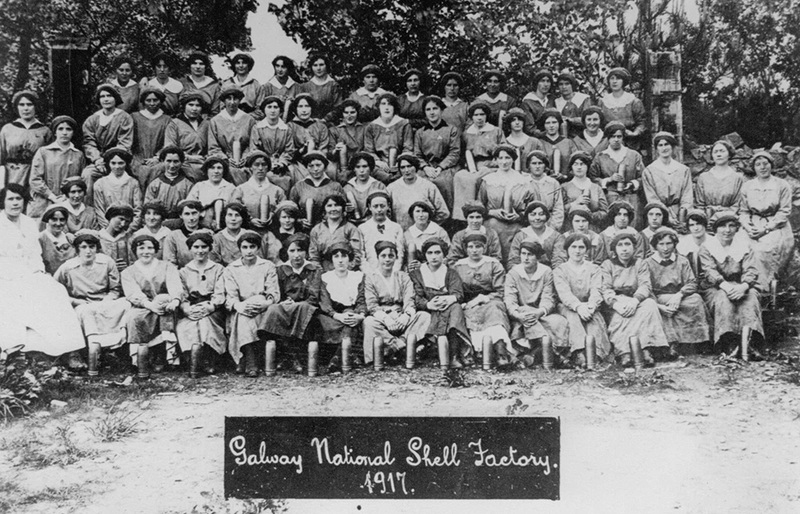
Image courtesy of NUI Galway Library
1922
Due to the 'disorganisation and uncertainty caused by the war', there were no Headford Shows in 1914 or 1919, and no record of any taking place after 1922. In the latter years of the show, there is no record of a Headford Lace category.
1937-1939
Chrissie Forde, a primary school pupil at Clochar na Trócaire (Convent of Mercy) in Tuam, reports to the Irish Folklore Commission on the recollections of her father, Joseph Forde:
The lace that the old women wore on their bonnets was made around Headford. It was made special for old women's bonnets. It was brought into Dunmore and Tuam ad sold at 4 pence a yard. It was made by women and they called it thread lace.Forde, Chrissie (1937-1939) 'Buying and Selling'. The Schools’ Collection, Volume 0027, Page 0076. National Folklore Collection, University College Dublin, accessed 15 August 2020.
Mid-Twentieth Century
The twentieth century represents the biggest, and likely the only gap in the lacemaking industry in Headford since it was first established.
1985
A newspaper article about the Presentation College in Headford reports that 'Sister Fursey remembers that the girls also did what was known as lace work and crochet – indeed Headford lace – now no longer to be found, was taught by a Miss Lee. Mr. Jim McHugh, retired N.T., recollects […] that efforts to locate samples for the Galway Quincentennial celebrations last year proved fruitless.'The Connacht Tribune, 11 October 1985, p. 7. 'Presentation College Headford collects environmental award'
1986
A City Tribune report on an ICA meeting of Galway TA (Town Association) members, who enjoyed a presentation on lace by Mrs. Ó Ceallaigh (believed to be a mistaken report of Nellie Ó Cléirigh), who had with her 'samples of lace from her huge collection go[ing] back to the time of the Famine and by coincidence some of the pieces came her way from U.C.G. and from Headford'.City Tribune, 14 February 1986, p. 4. 'City ICA members enjoy lace talk!' Headford Lace Project have been unable to confirm the existence of Headford Lace in Ms. Ó Cléirigh's collection.
2016
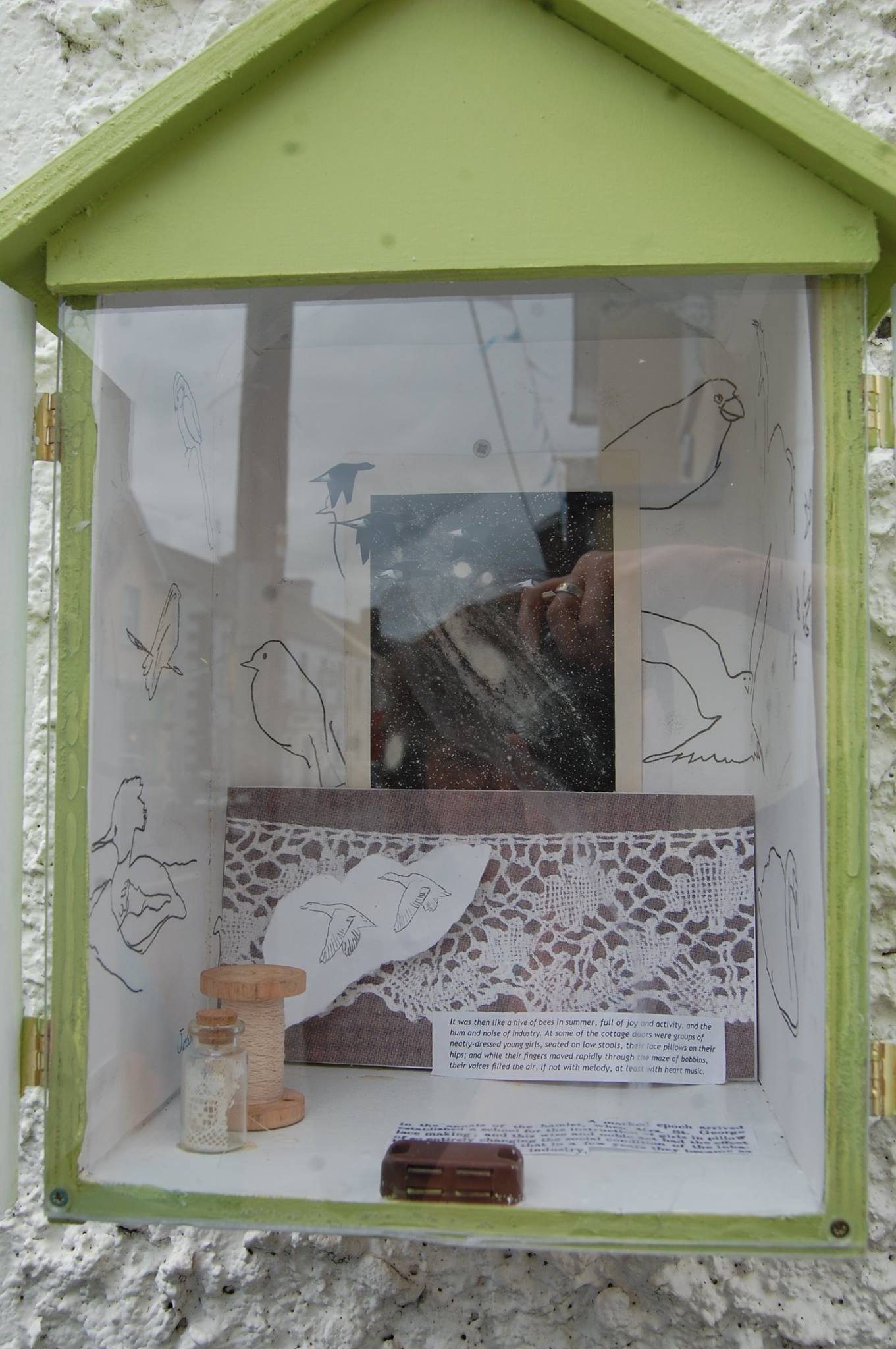
A five-day cultural event called The Nesting Lark took place in Headford from 25-29 May. Visual artist Selma Makela created an art trail of bird-box installations throughout the town. This photo shows one of the installations that focused on the history of Headford's lacemaking tradition. It was a collaboration with the pupils of Headford Girls' National School, and the research conducted by the children is archived on the school website.
Selma's initial research on Headford Lace for The Nesting Lark prompted that project's administrator, Ester Kiely, and artistic director, Eilís Nic Dhonncha, to investigate the story futher. They contacted Anne O'Hara Quinn, who had been a member of the Traditional Lacemakers of Ireland for some years. Anne arranged a lacemakers' gathering at the Museum of Country Life, where Ester and Selma met Jackie Magnin, a lacemaker from West Cork. Jackie had used a photograph of the 1904 sample of Headford Lace to identify the lace as a type of Torchon bobbin lace and to create an exact replica. Jackie thus became the first person for a century to make Headford Lace.
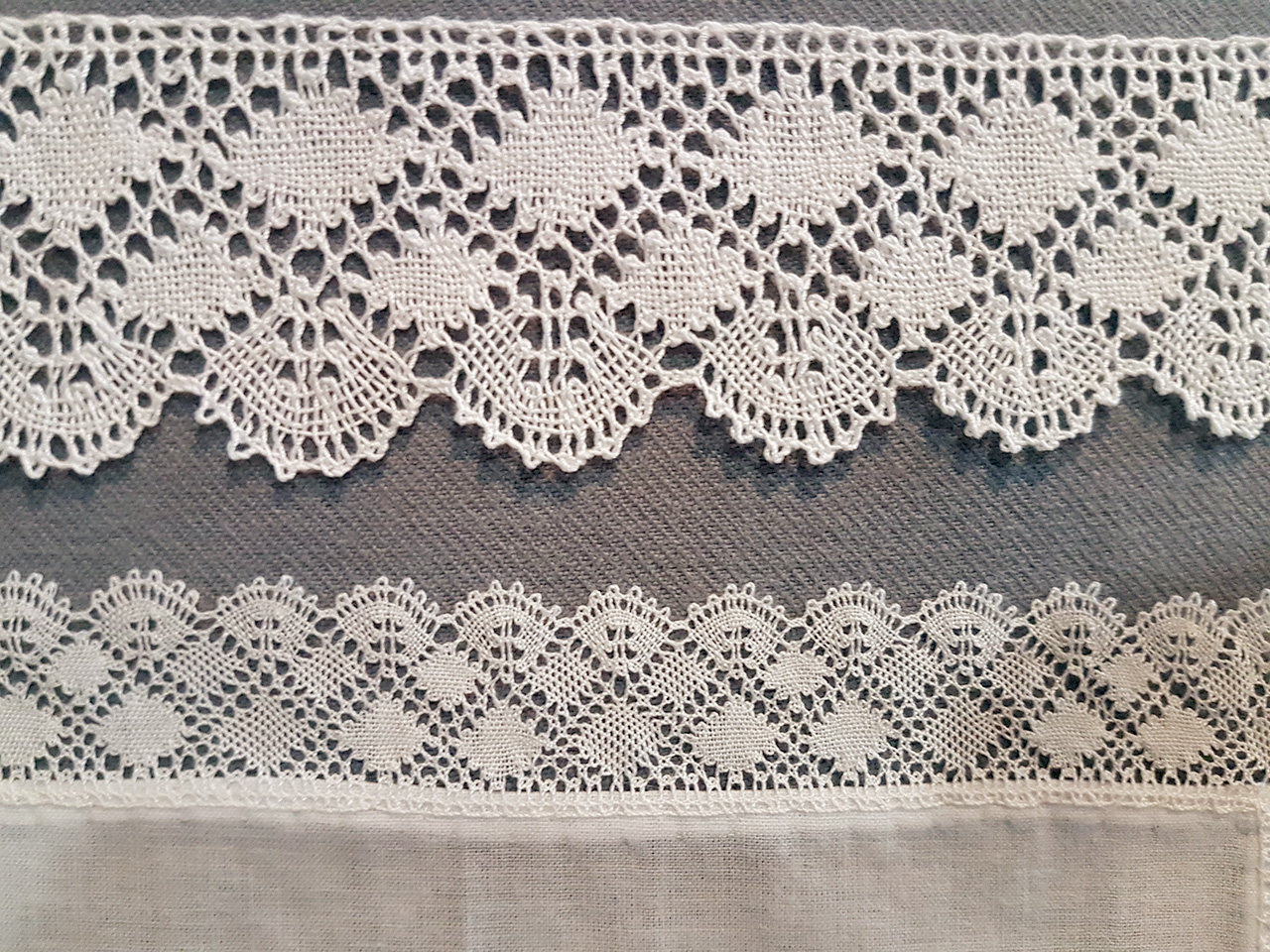
Replicas of Headford Lace made by Jackie Magnin
This group went on to establish a voluntary community initiative dedicated to the research, revival, and reimagination of Headford's lacemaking heritage. This group became the Headford Lace Project. Its first committee also included Ger Henry Hassett, Ella Hassett, Giulliana Victor Harte, and Rusty Weise.
The group organised its inaugural Headford Lace Weekend in November. A free talk was attended by approximately fifty people, and eight participated in a bobbin lace workshop with Jackie Magnin.
2017
Headford Lace Project is awarded the Tidy Towns Heritage Award by the Heritage Council with a prize fund of €1,000.
Over the course of the year, four more Headford Lace Weekends are organised, with almost 50 people attending workshops in bobbin lace. International links are forged with lacemakers in Slovenia and the USA.
Headford Lace Project enjoys local press coverage in the Tuam Herald, Connacht Tribune, and the Galway Independent. Articles about Headford Lace are written for the Guild of Irish Lacemakers' newsletter and Making.ie. The group also make presentations to the Guild of Irish Lacemakers, Renmore ICA, the Irish Patchwork Society, Galway Civic Trust, and Galway City Museum.
The Headford Lace Project Archive is established and includes a collection of historical research documents, donated lace samples, and a library of books on lacemaking.
Culture Night on 22 September becomes a celebration of Headford's lace heritage in the town. Intertwined, a week-long lace exhibition, was curated in 17 shop windows along the Main Street and into St. George's Square. A collaboration with Headford Camera Club resulted in a lace-themed photo exhibition. A 'selfie station' was created on the Main Street by Carrot Puppet Theatre. The Lacemaker's Shoes, a walking tour through the town, brought these various elements together. The evening culminated with a presentation by Veronica Stuart, assisted by Eleanor Power, of the Traditional Lacemakers of Ireland. After dark, a large-scale slideshow on Main Street projected images of lace onto the side of a building.
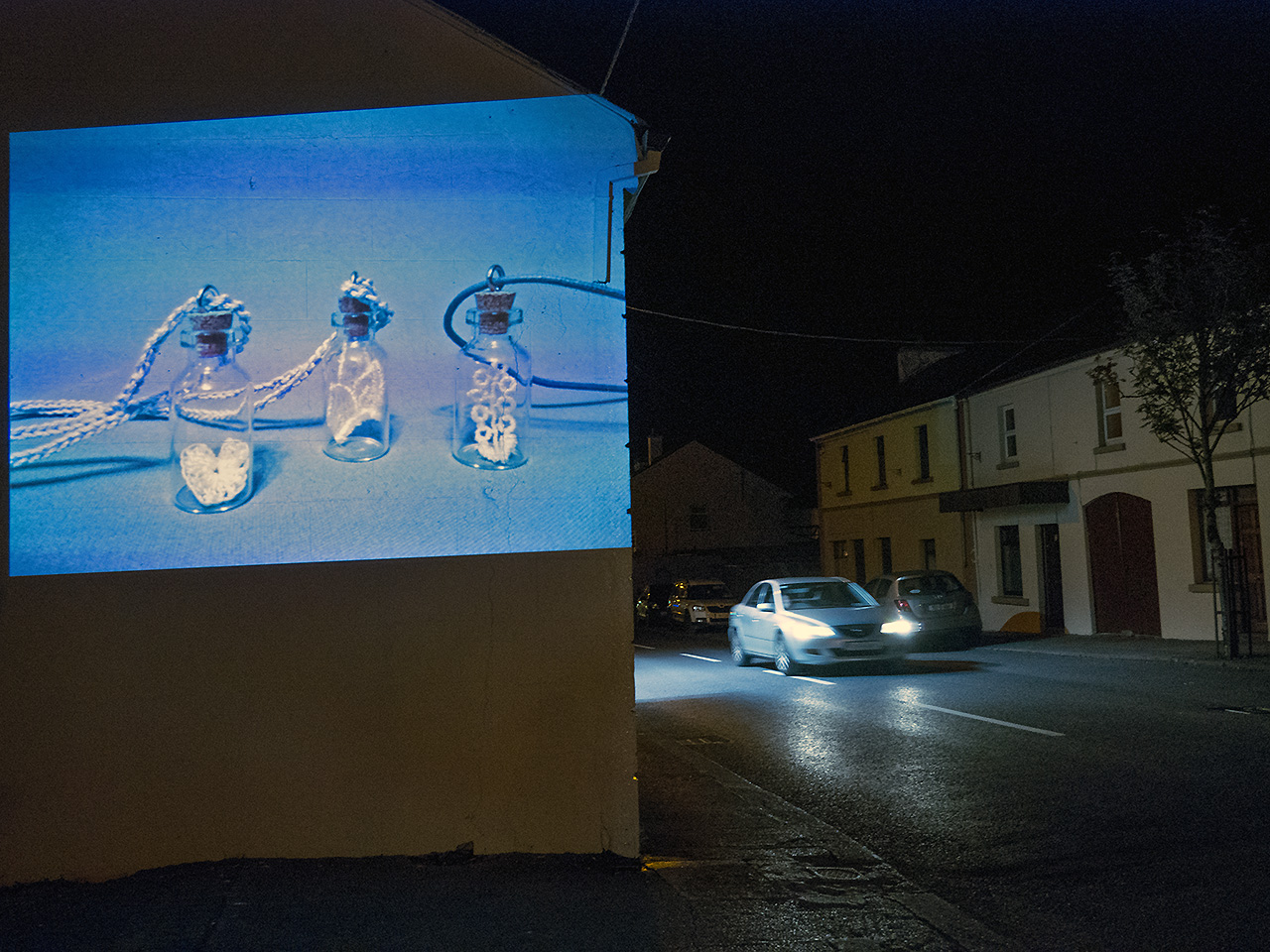
Throughout the year, Headford Lace Project also hosts a Vintage Lace Tea Party, collaborates with the Men's Shed and local master woodturners, Bríd and Ambrose O'Halloran, to make bobbins, and organises presentations and demonstrations of bobbin lacemaking in St. George's Square on St. Patrick's Day, as well as at Kilconly Food & Craft Fair, Athenry Agricultural Show, Headfest, Ballinrobe Heritage Day & Market, Galway Fringe Festival, and at the Galway Civic Trust during Heritage Week.
2018
The Headford Lace Project community grows significantly with over 60 ‘apprentices’, who have attended a beginners bobbin lacemaking workshop. The email subscription list numbers over 200, there are over 900 Facebook followers and over 400 Instagram followers.
Norma Owens joins the committee of Headford Lace Project. She designs the website, which is launched on St. Patrick's Day. She is also the first apprentice to successfully replicate the original piece of Headford Lace based on the pattern created by Jackie Magnin.
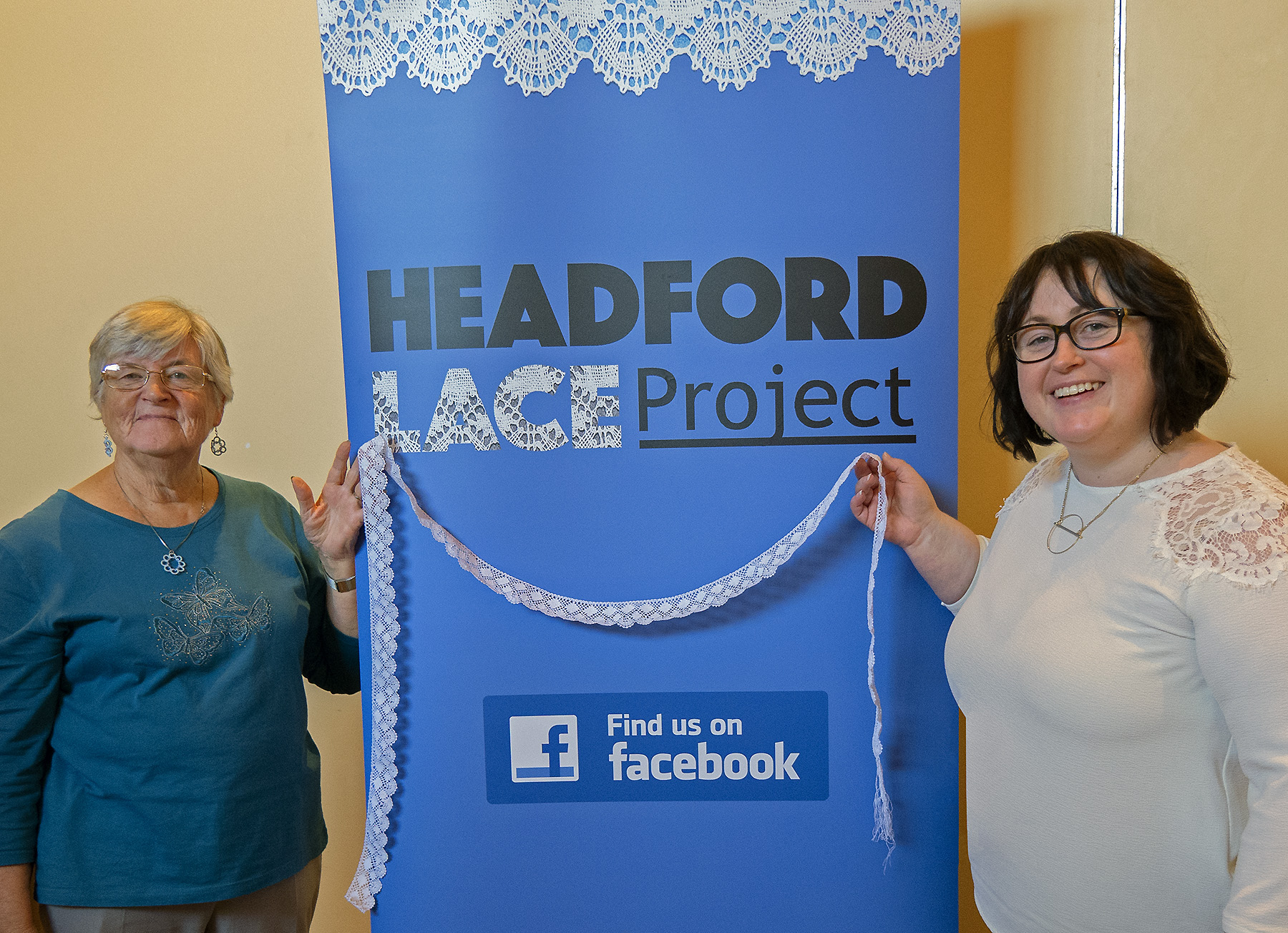
Tutor Jackie Magnin with apprentice Norma Owens and her first piece of Headford Lace
Headford Lace Project was shortlisted for the Cathaoirleach's Community Awards for best contribution to heritage and outstanding work in this area.
Headford Lace Project uses its prize fund from the 2017 Tidy Towns Heritage Award and combined it with Facilities funding from Galway County Council to commission a bench inspired by Headford Lace in order to leave a permanent legacy in the town. Kilkee Forge were selected to produce this bench. A collaboration with the Headford Environment Group led to the creation of a bobbin-inspired fence. Both the bench and the fence were installed by the Rural Social Scheme, and they now form the structure of the Lacemakers' Garden in the Community Orchard at White Church. The Headford Environment Group have planted the garden with lacelike plants that are also attractive to pollinators.
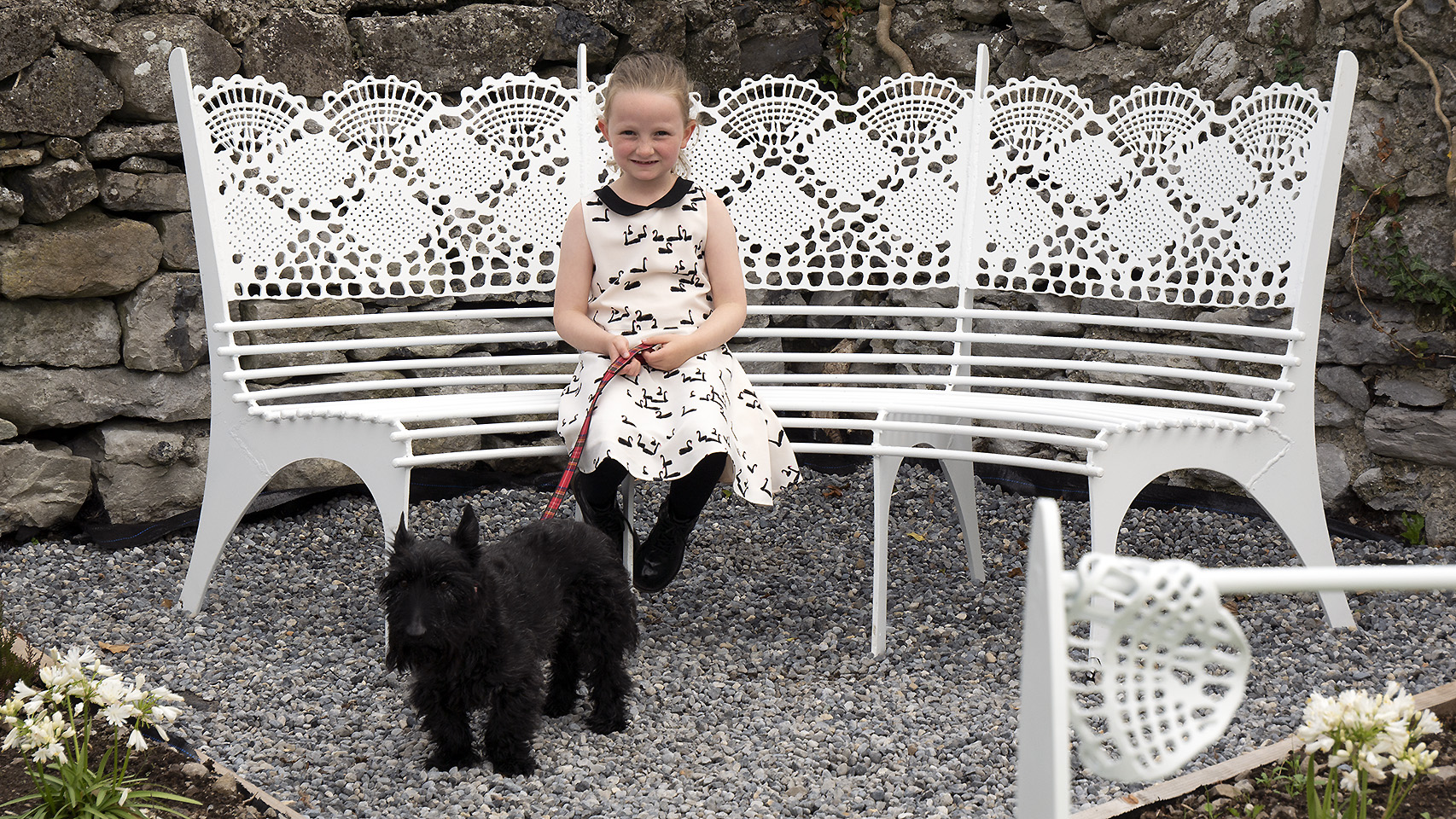
Headford Lace Project continues to develop the story of Headford Lace. You can learn more about our activities by selecting the Reimagine menu above.


